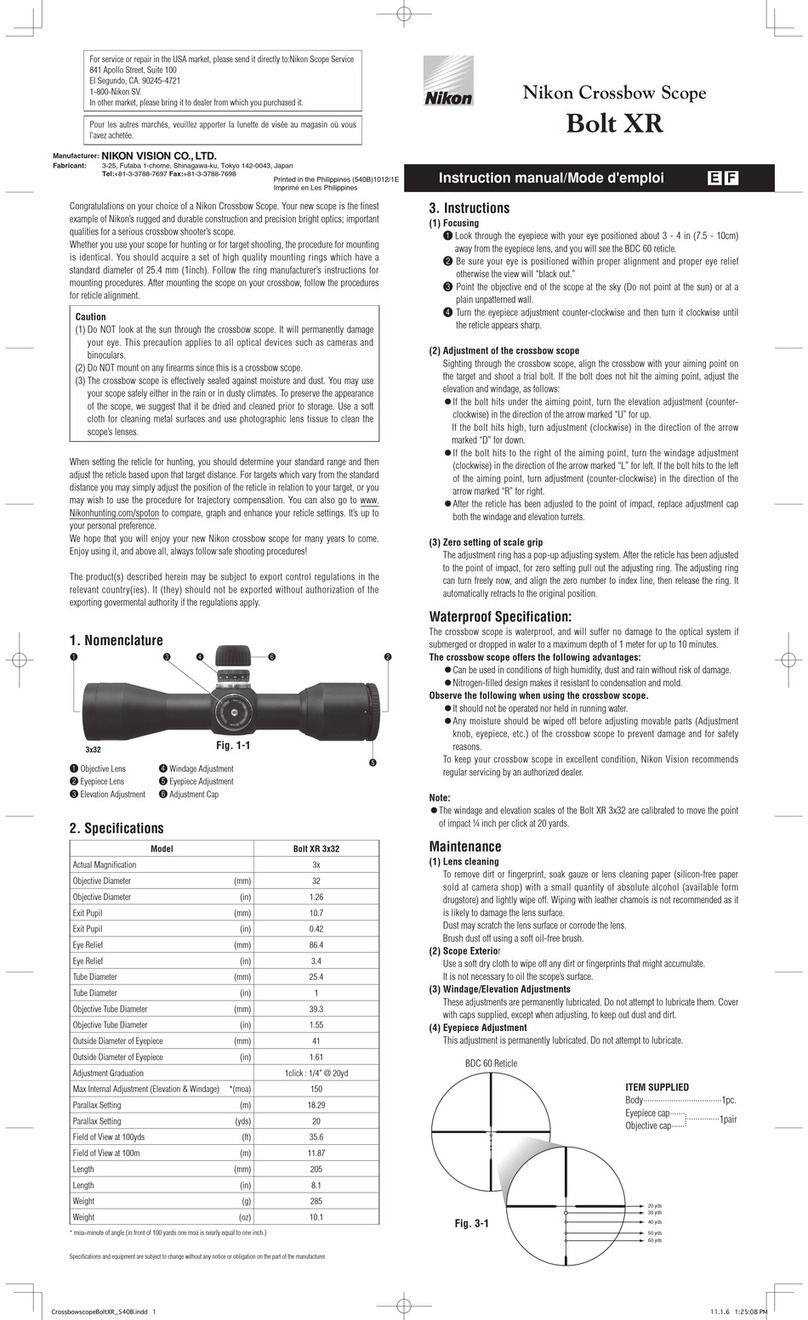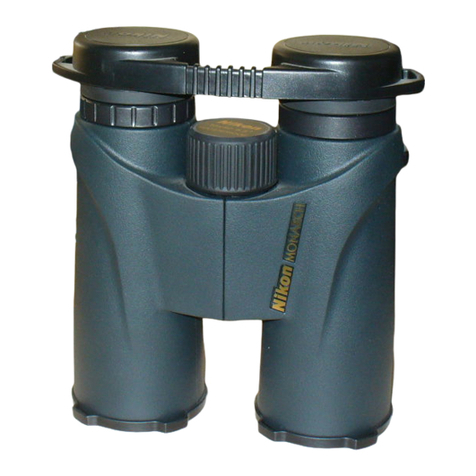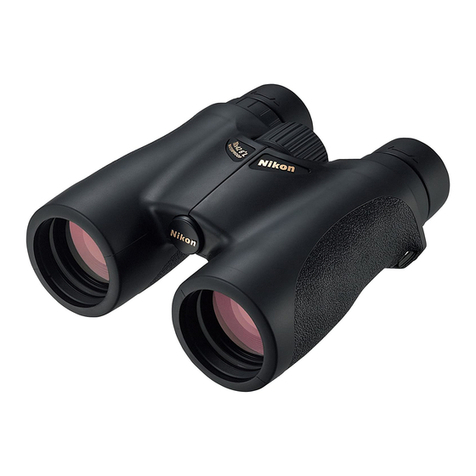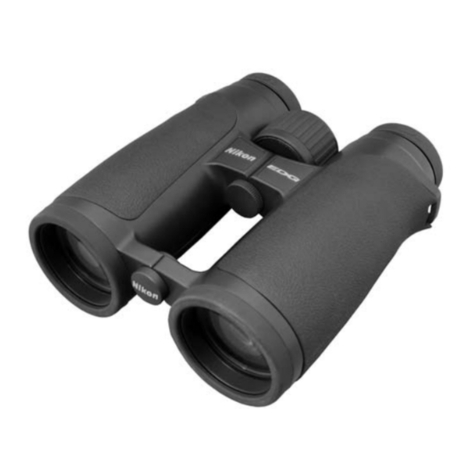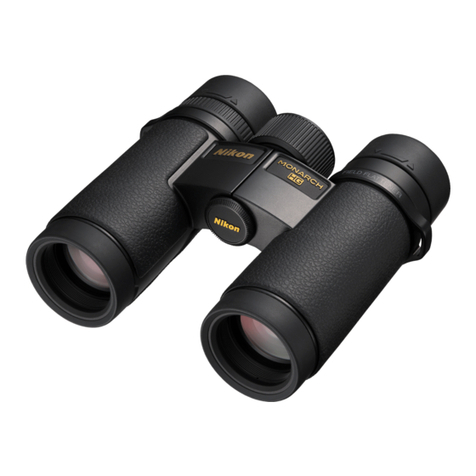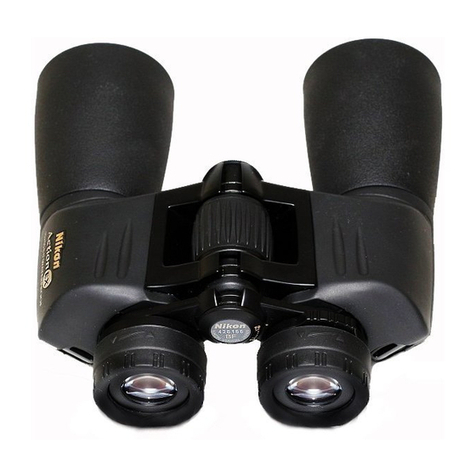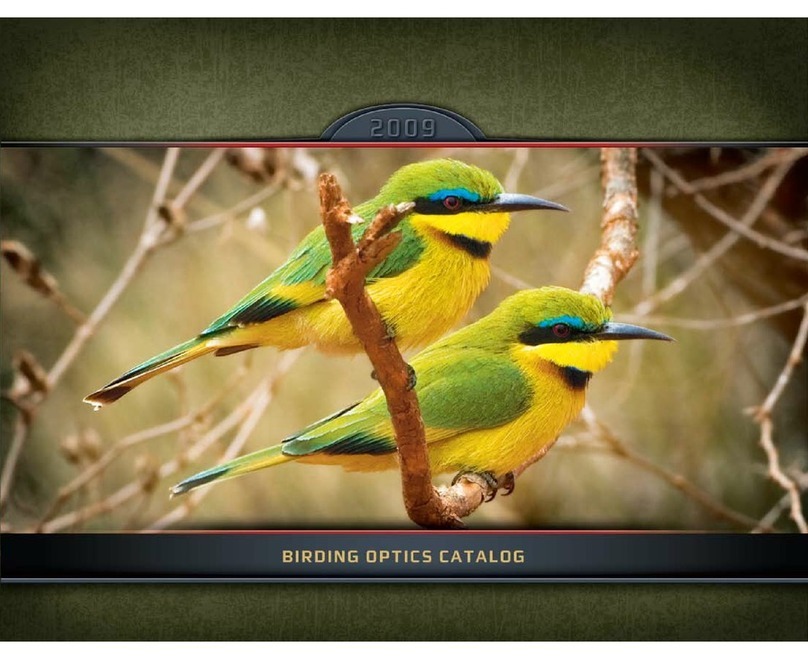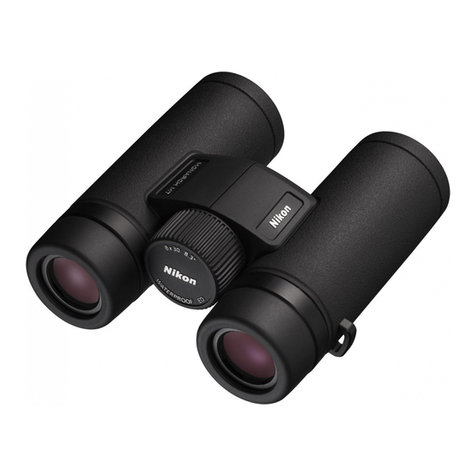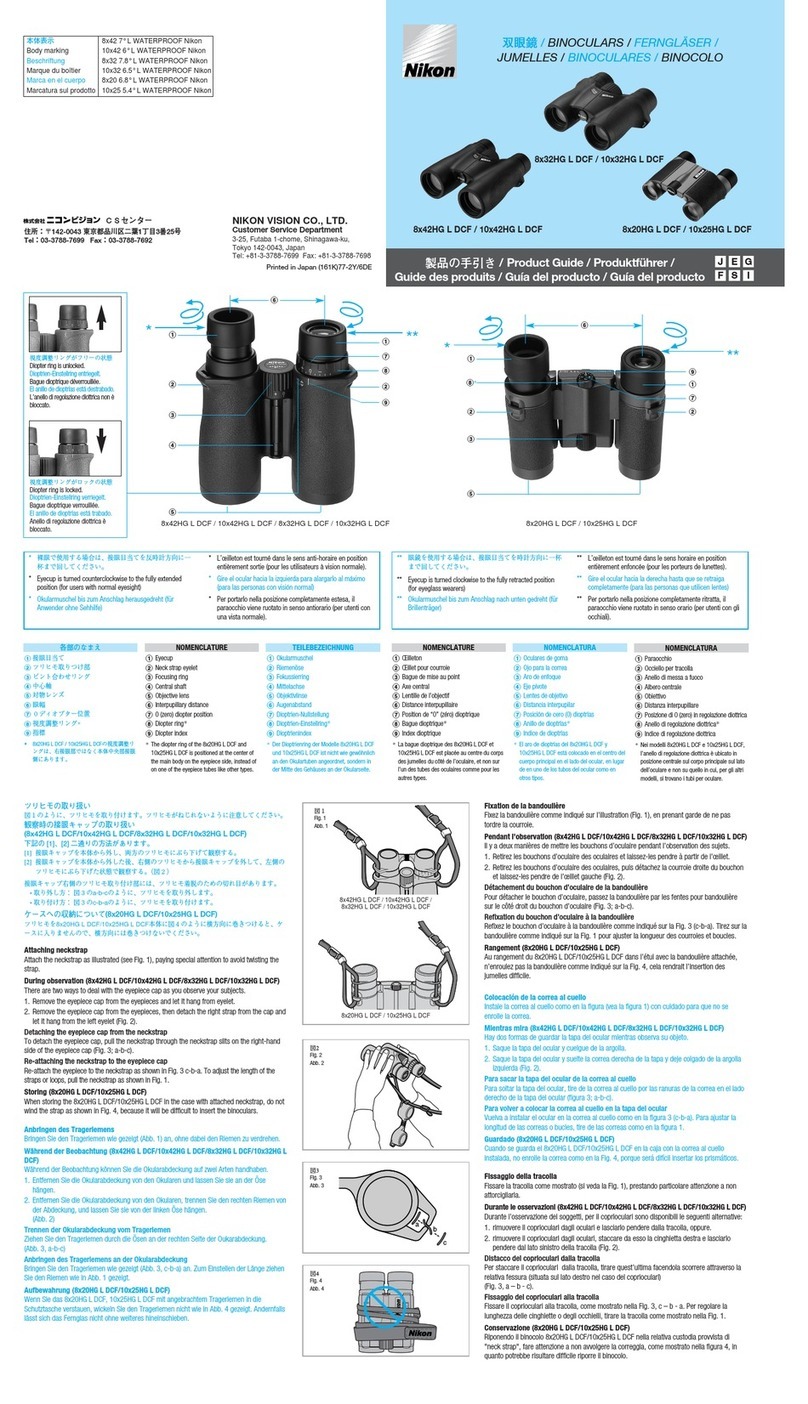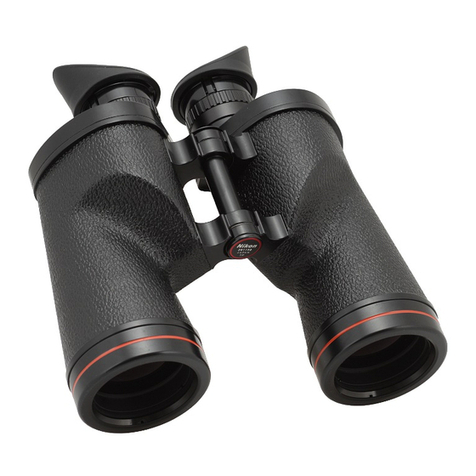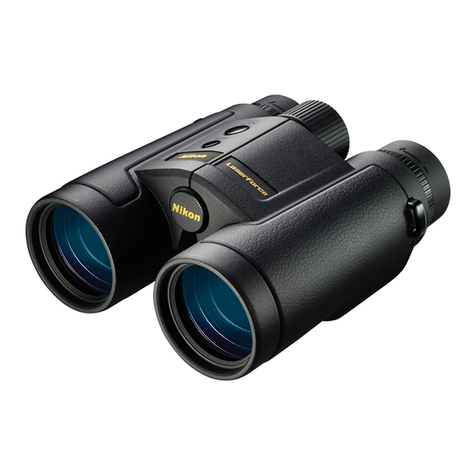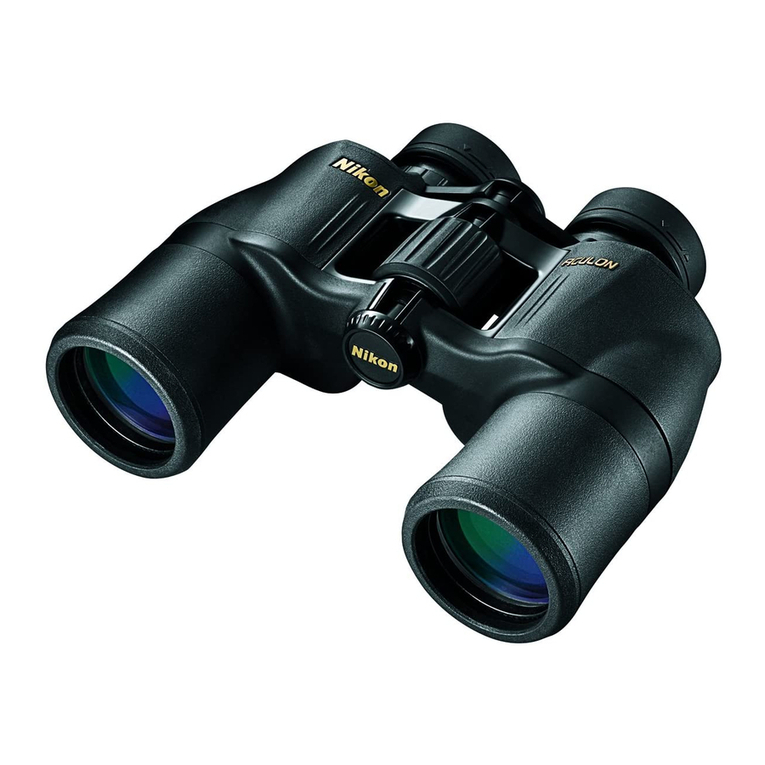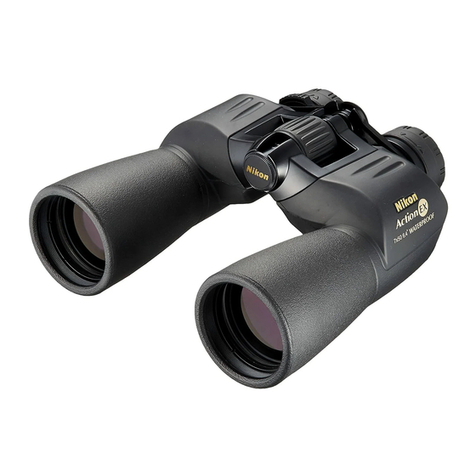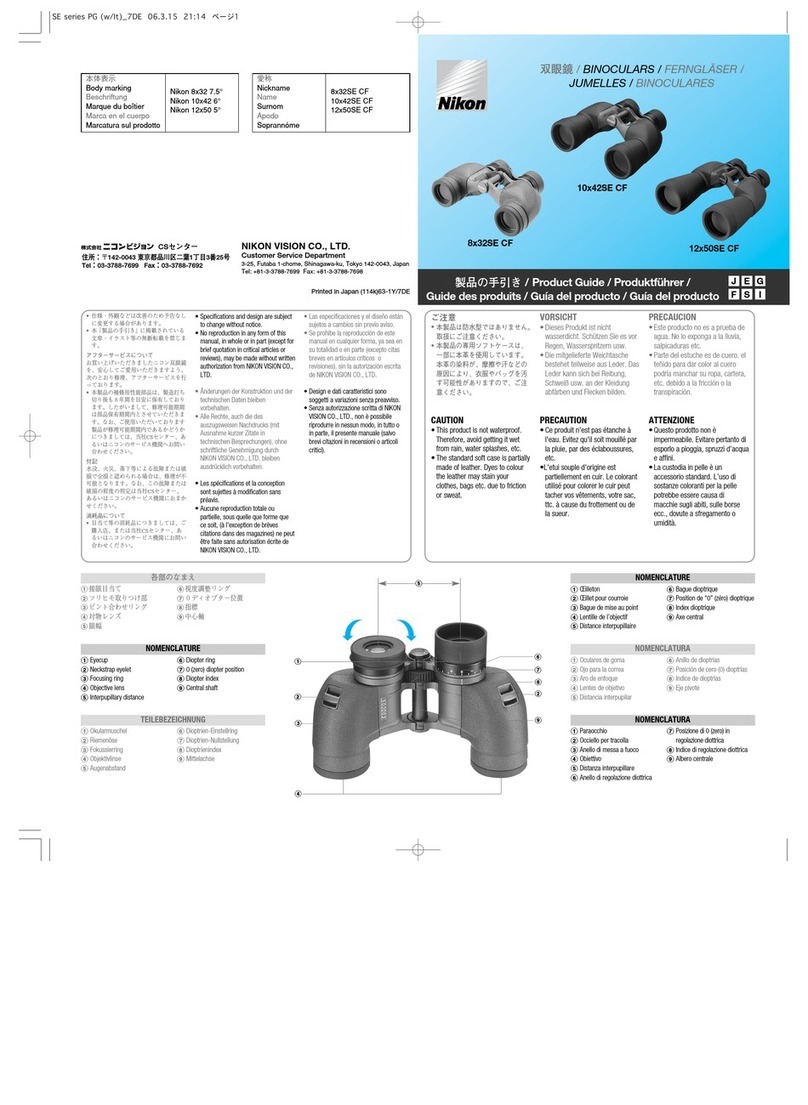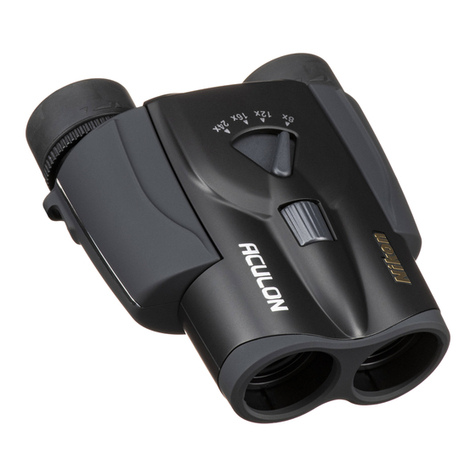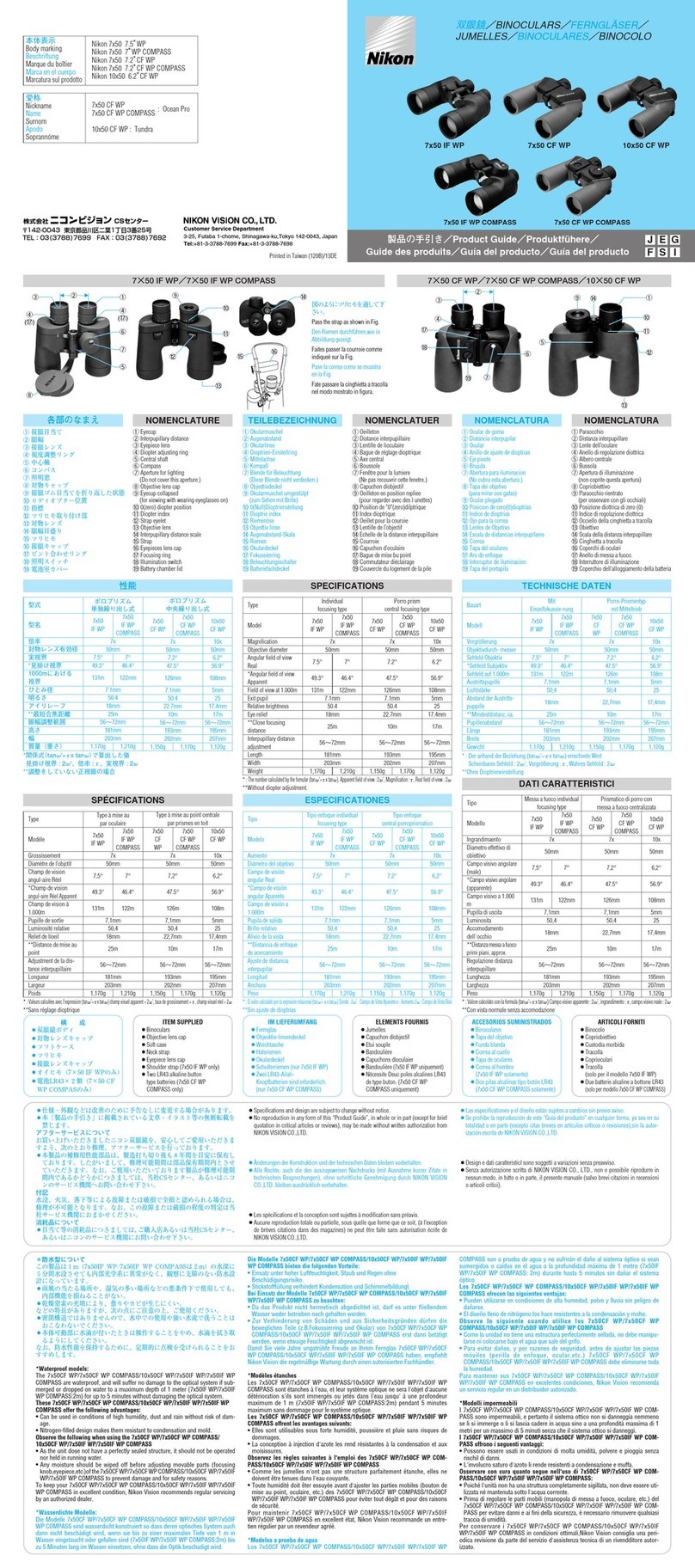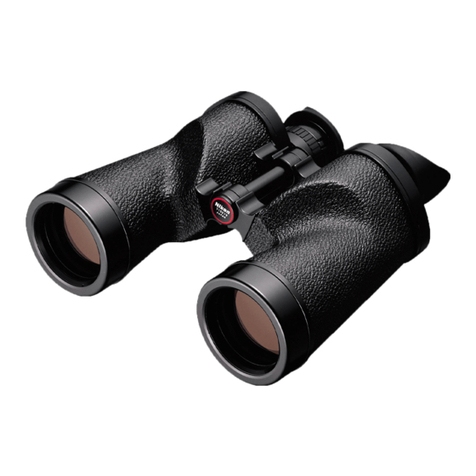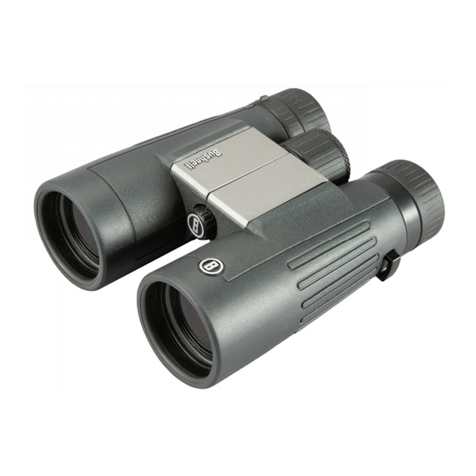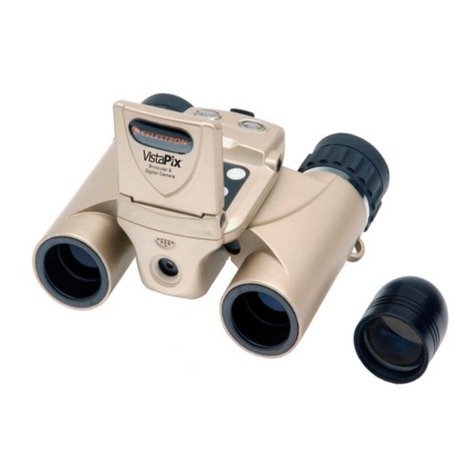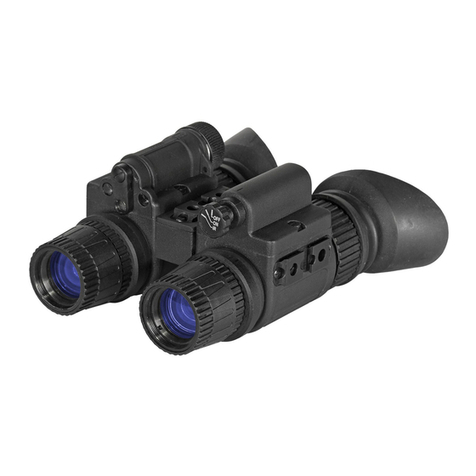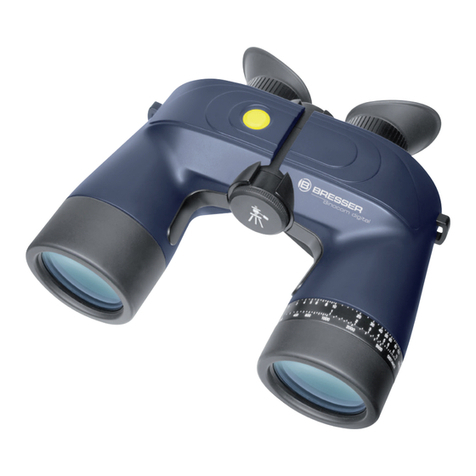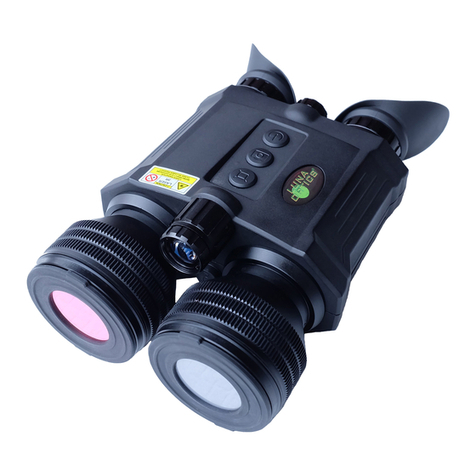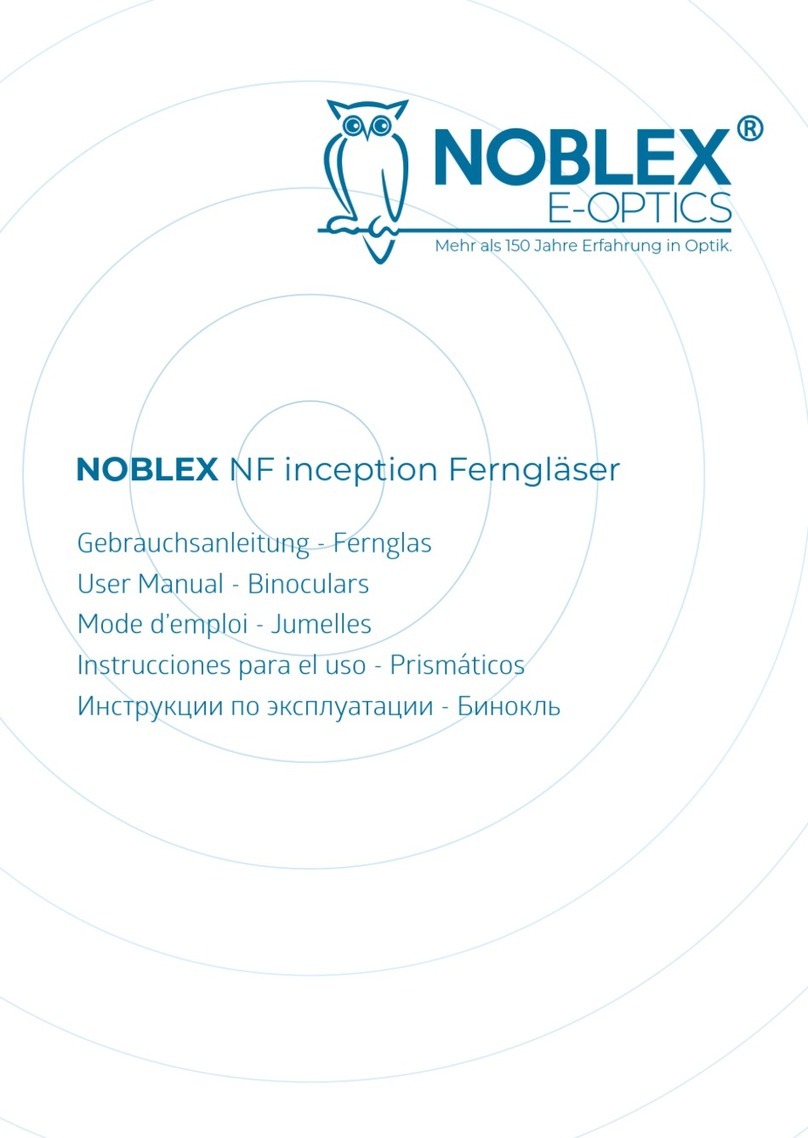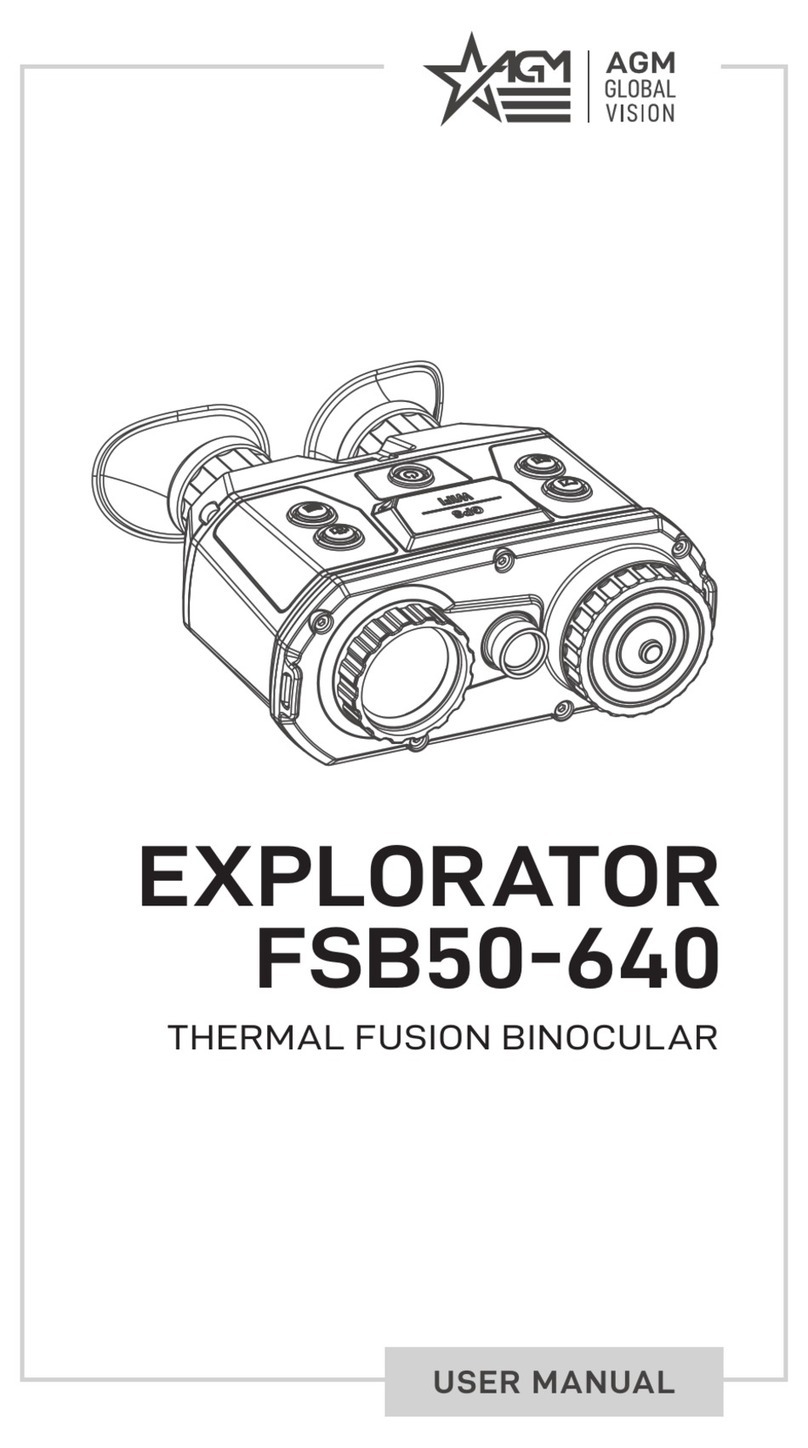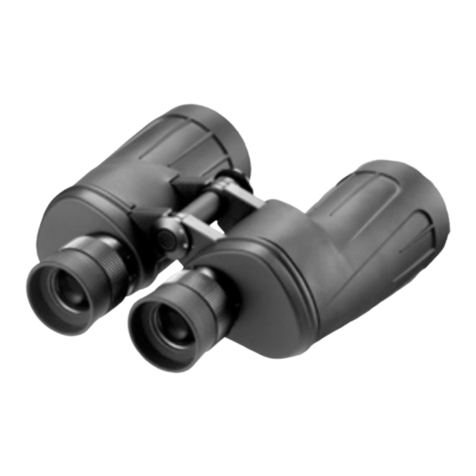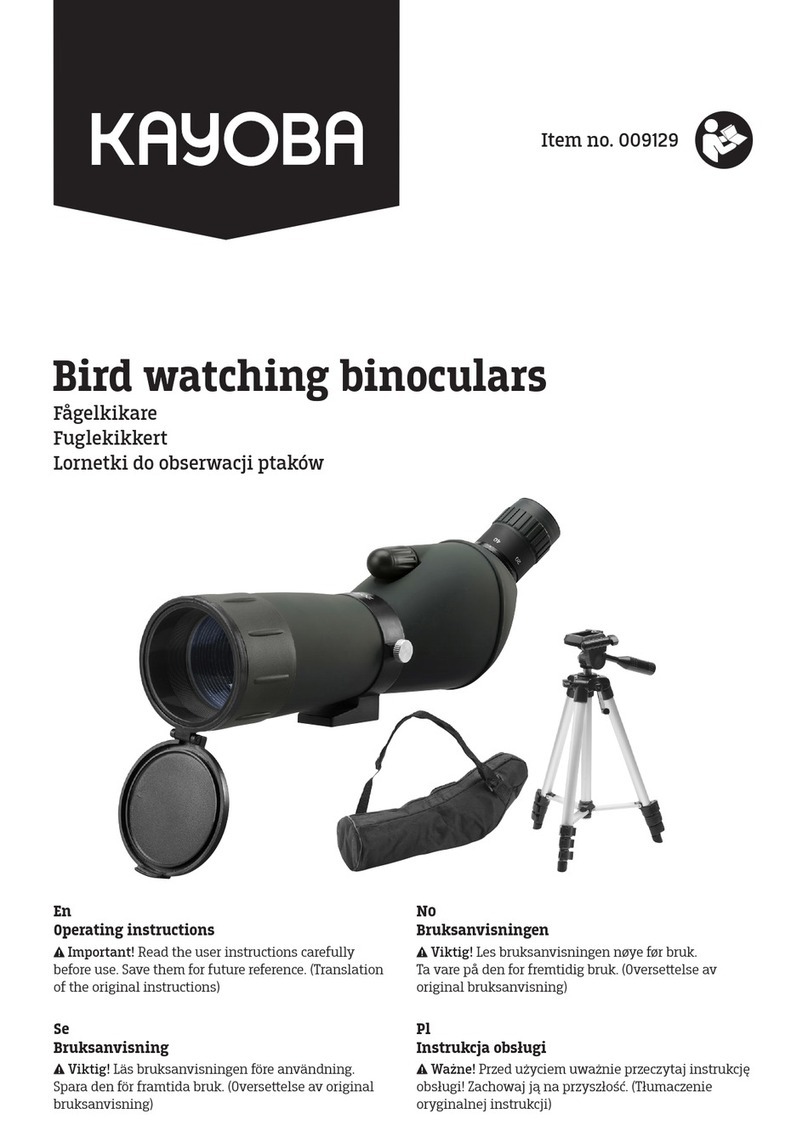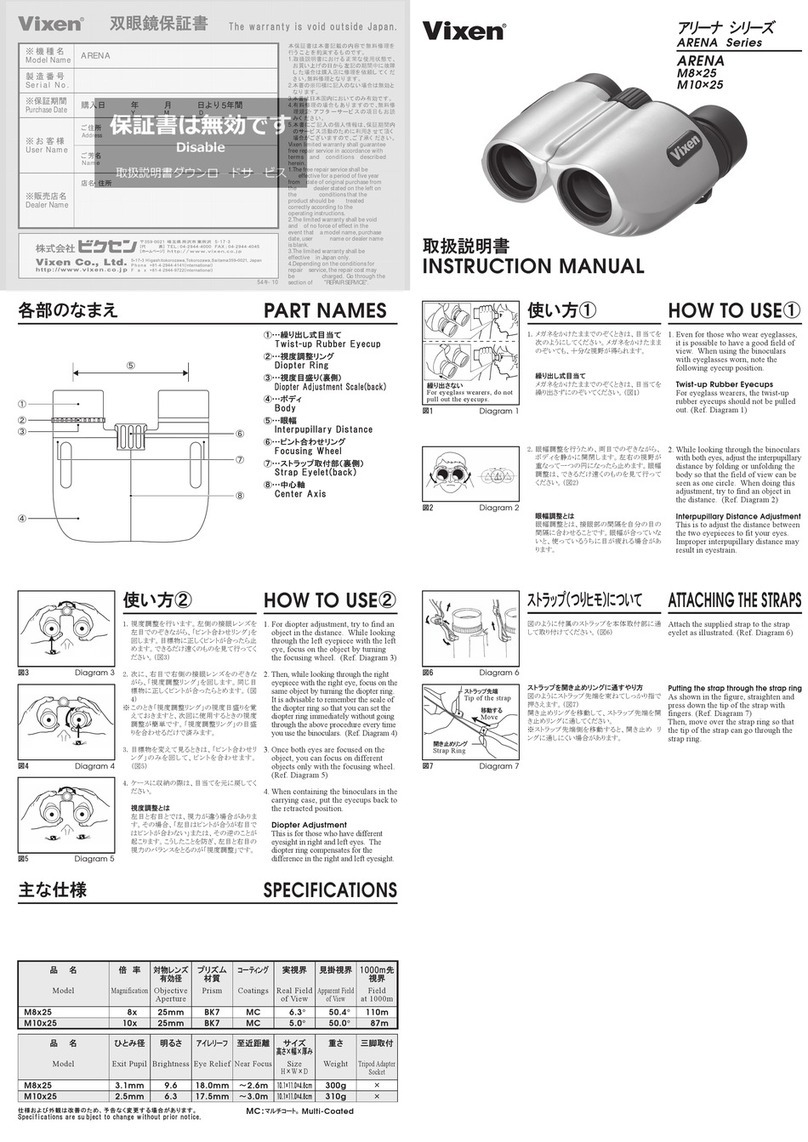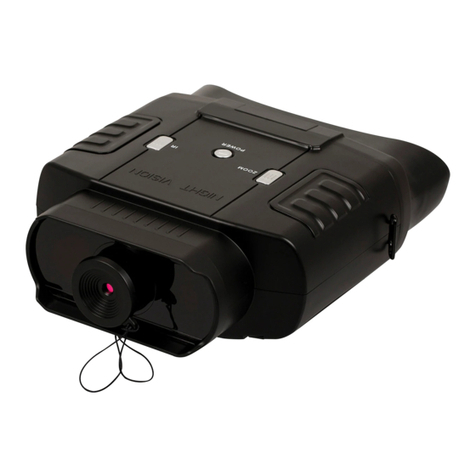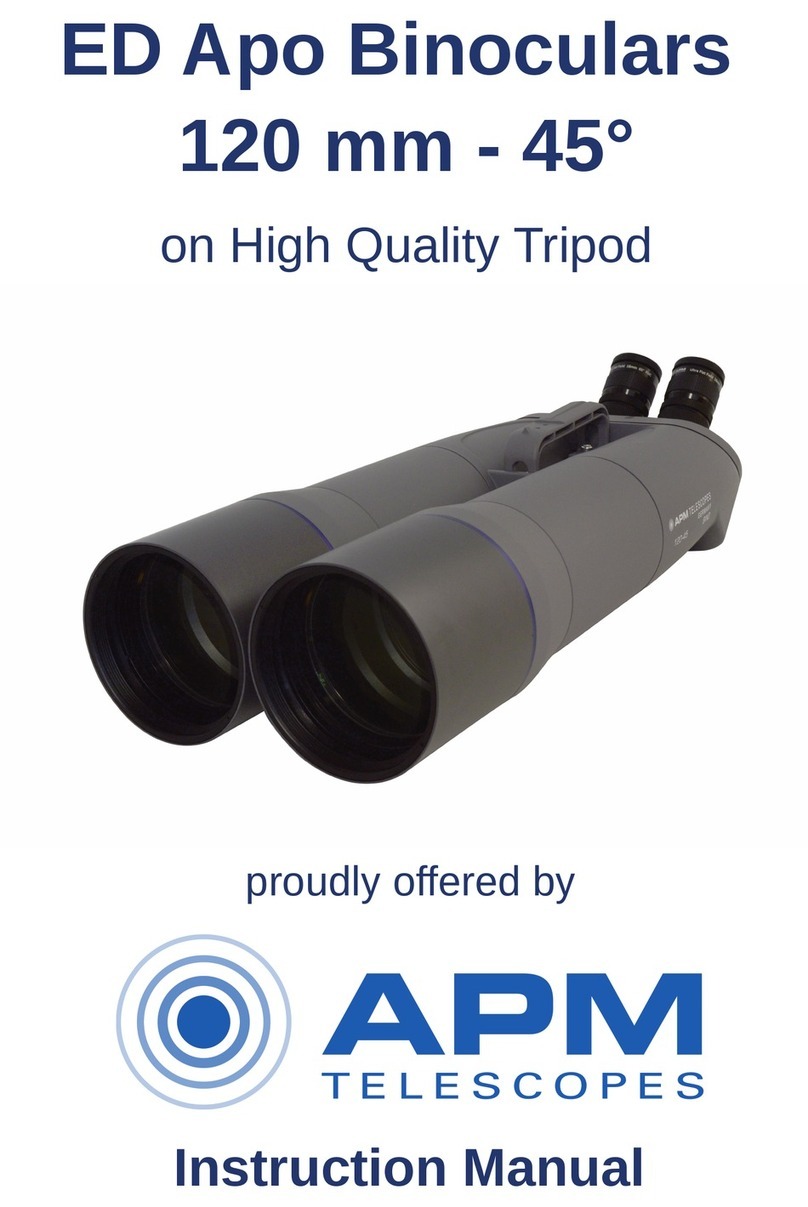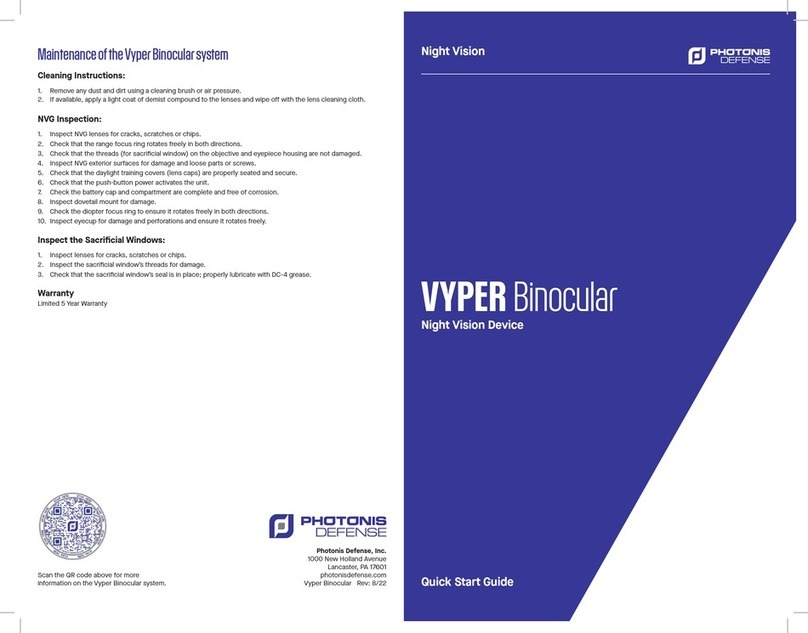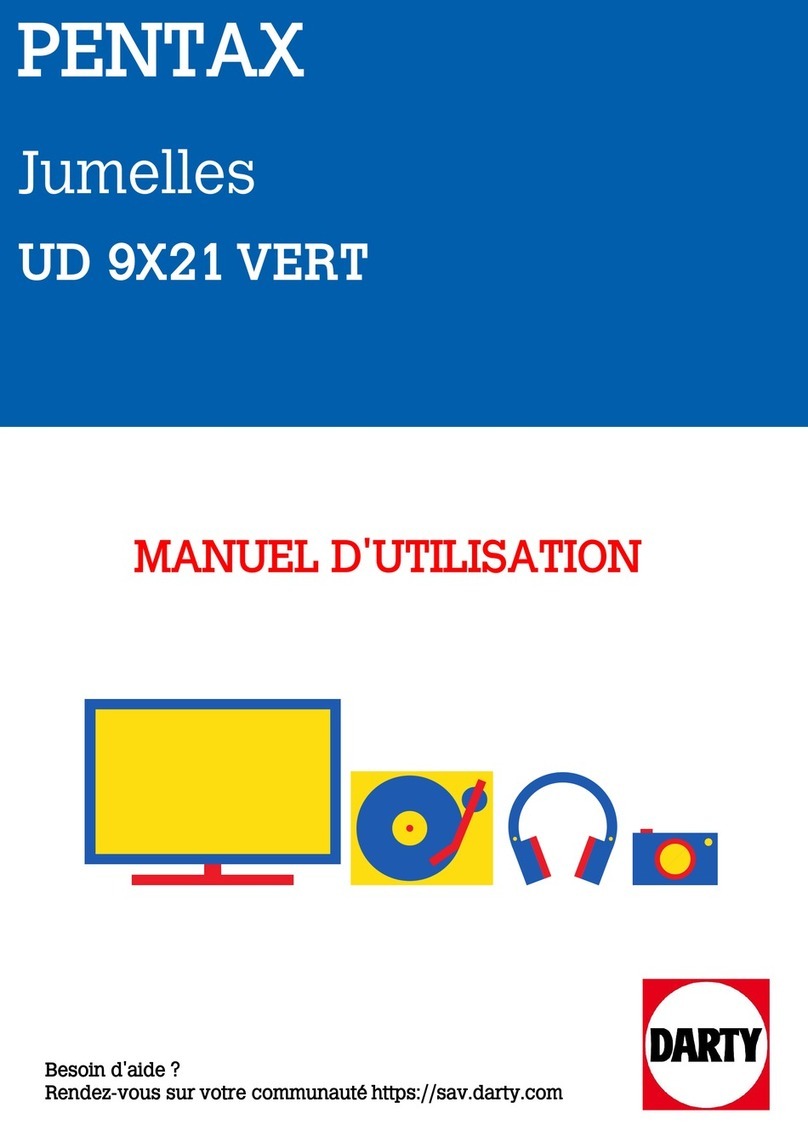Caratteristiche tecniche delle singole lenti per oculare
( ): Coni modelli Fieldscope ED82/ED82 A
*In caso di selezione del valore minimo di ingrandimento
La lente dell’obiettivo dei modelli Fieldscope ED82/ED82 A/EDIII/EDIII A è del tipo ED (a bassissima dispersione). Si tratta di lenti ad elevate
prestazioni sviluppate in esclusiva da Nikon per presentare caratteristiche di dispersione eccezionalmente ridotte. Esse compensano
completamente l’aberrazione cromatica in modo da fornire immagini nitide e dotate di un contrasto elevato.
Especificaciones de cada ocular
Modelo
24x/30x 30x/38x 40x/50x 60x/75x 20-45x/ 20-60x/ 20x/25x 40x/50x 24x/30x 40x/50x 60x/75x
gran gran gran gran 25-56x 25-75x MC MC gran gran gran
angular MC angular MC angular MC angular MC MC MC II angular DS angular DS angular DS
Aumento 24x 30x 40x 60x 20x-45x 20x-60x 20x 40x 24x 40x 60x
(30x) (38x) (50x) (75x) (25x-56x) (25x-75x) (25x) (50x) (30x) (50x) (75x)
Campo de 3,0° 2,4° 1,8° 1,2° 2,0°* 2,0°* 3,0° 1,1° 3,0° 1,8° 1,2°
visión real (2,4°) (1,9°) (1,4°) (1,0°) (1,6°*) (1,6°*) (2,4°) (0,9°) (2,4°) (1,4°) (1,0°)
Campo de visión 72° 72° 72° 72° 40°* 40°* 60° 44° 72° 72° 72°
apparemte (72°) (72°) (72°) (72°) (40°*) (40°*) (60°) (45°) (72°) (72°) (72°)
Campo de visión 52m 42m 31m 21m 35m* 35m* 52m 19m 52m 31m 21m
1,000m (Aprox.) (42m) (33m) (24m) (17m) (28m*) (28m*) (42m) (16m) (42m) (24m) (17m)
Pupila de 2,5mm 2,0mm 1,5mm 1,0mm 3,0mm* 3,0mm* 3,0mm 1,5mm 2,5mm 1,5mm 1,0mm
salida (2,7mm) (2,2mm) (1,6mm) (1,1mm) (3,3mm*) (3,3mm*) (3,3mm) (1,6mm) (2,7mm) (1,6mm) (1,1mm)
Brillo 6.3 4.0 2.3 1.0 9.0* 9.0* 9.0 2.3 6.3 2.3 1.0
(7,3) (4,8) (2.,6) (1,2) (10,9*) (10,9*) (10,9) (2,6) (7,3) (2.,6) (1,2)
Distancia aprox. de la 15,1mm 17,9mm 17,8mm 17,0mm 12,9mm* 14,1mm* 15,2mm 9,4mm 18,7mm 17,8mm 17,0mm
pupila de salida al ocular (15,1mm)(17,9mm)(17,8mm) (17,0mm) (12,9mm*) (14,1mm*) 15,2mm 9,4mm (18,7mm) (17,8mm) (17,0mm)
( ): Con Caralejo ED82/ED82 A
*Cuando de selecciona el aumento minimo
El Objetivo del Catalejo ED82/ED82 A/EDIII/EDIII A está hecho con lentes ED. La lente ED (dispersión extrabaja) es una lente
desarrollada exclusibamente por Nikon con características de dispersión extraordinariamente baja. Esta lente compensa
completamente la aberración cromática a fin de ofrecer imáfenes nítidas y de gran comtraste.
Spécifications de chaque oculaire
Modèle
24x/30x 30x/38x 40x/50x 60x/75x 20-45x/ 20-60x/ 20x/ 40x/ 24x/30x 40x/50x 60x/75x
Grand- Grand- Grand- Grand- 25-56x 25-75x 25x 50x Grand- Grand- Grand-
angulaire angulaire angulaire angulaire MC MC II MC MC angulaire angulaire angulaire
MC MC MC MC DS DS DS
Grossissement 24x 30x 40x 60x 20x-45x 20x-60x 20x 40x 24x 40x 60x
(30x) (38x) (50x) (75x) (25x-56x) (25x-75x) (25x) (50x) (30x) (50x) (75x)
Champ optique 3,0° 2,4° 1,8° 1,2° 2,0°* 2,0°* 3,0° 1,1° 3,0° 1,8° 1,2°
arrière (2,4°) (1,9°) (1,4°) (1,0°) (1,6°*) (1,6°*) (2,4°) (0,9°) (2,4°) (1,4°) (1,0°)
Champ optique 72° 72° 72° 72° 40°* 40°* 60° 44° 72° 72° 72°
apparent (72°) (72°) (72°) (72°) (40°*) (40°*) (60°) (45°) (72°) (72°) (72°)
Champ optique 52m 42m 31m 21m 35m* 35m* 52m 19m 52m 31m 21m
à 1,000m (env.) (42m) (33m) (24m) (17m) (28m*) (28m*) (42m) (16m) (42m) (24m) (17m)
Pupille de sortie 2,5mm 2,0mm 1,5mm 1,0mm 3,0mm* 3,0mm* 3,0mm 1,5mm 2,5mm 1,5mm 1,0mm
(2,7mm) (2,2mm) (1,6mm) (1,1mm) (3,3mm*) (3,3mm*) (3,3mm) (1,6mm) (2,7mm) (1,6mm) (1,1mm)
Luminosité 6,3 4,0 2,3 1,0 9,0* 9,0* 9,0 2,3 6,3 2,3 1,0
(7,3) (4,8) (2,6) (1,2) (10,9*) (10,9*) (10,9) (2,6) (7,3) (2,6) (1,2)
Dégagement 15,1mm 17,9mm 17,8mm 17,0mm 12,9mm* 14,1mm* 15,2mm 9,4mm 18,7mm 17,8mm 17,0mm
oculaire (15,1mm)(17,9mm)(17,8mm)(17,0mm) (12,9mm*) (14,1mm*) 15,2mm 9,4mm (18,7mm) (17,8mm) (17,0mm)
( ): Avec Lunette terrestre ED82/ED82 A
*Quand le grossissement minimum
L’objectif de la Lunette terrestre ED82/ED82 A/EDIII/EDIIIA est composé de lentilles ED. L’objectif ED (Extra-low
Dispersion) est un objectif haute performance mis au point spécialement par Nikon, caractérisé par une faible dispersion. Il
compense parfaitement les aberrations chromatiques et contribue à l’obtention d’une image nette et bien contrastée.
Technische Daten von allen Okularen
Modell
24x/30x 30x/38x 40x/50x 60x/75x 20-45x/ 20-60x/ 20x/ 40x/ 24x/30x 40x/50x 60x/75x
Weitwinkel Weitwinkel Weitwinkel Weitwinkel 25-56x 25-75x 25x 50x Weitwinkel Weitwinkel Weitwinkel
MC MC MC MC MC MC II MC MC DS DS DS
Vergrößerung 24x 30x 40x 60x 20x-45x 20x-60x 20x 40x 24x 40x 60x
(30x) (38x) (50x) (75x) (25x-56x) (25x-75x) (25x) (50x) (30x) (50x) (75x)
Sehfeld objektiv 3,0° 2,4° 1,8° 1,2° 2,0°* 2,0°* 3,0° 1,1° 3,0° 1,8° 1,2°
(2,4°) (1,9°) (1,4°) (1,0°) (1,6°*) (1,6°*) (2,4°) (0,9°) (2,4°) (1,4°) (1,0°)
Sehfeld 72° 72° 72° 72° 40°* 40°* 60° 44° 72° 72° 72°
subjektiv (72°) (72°) (72°) (72°) (40°*) (40°*) (60°) (45°) (72°) (72°) (72°)
Sehfeld auf 52m 42m 31m 21m 35m* 35m* 52m 19m 52m 31m 21m
1,000m (Ca.) (42m) (33m) (24m) (17m) (28m*) (28m*) (42m) (16m) (42m) (24m) (17m)
Austrittspupille 2,5mm 2,0mm 1,5mm 1,0mm 3,0mm* 3,0mm* 3,0mm 1,5mm 2,5mm 1,5mm 1,0mm
(2,7mm) (2,2mm) (1,6mm) (1,1mm) (3,3mm*) (3,3mm*) (3,3mm) (1,6mm) (2,7mm) (1,6mm) (1,1mm)
Lichtstärke 6,3 4,0 2,3 1,0 9,0* 9,0* 9,0 2.3 6,3 2,3 1,0
(7,3) (4,8) (2.,6) (1,2) (10,9*) (10,9*) (10,9) (2,6) (7,3) (2.,6) (1,2)
Abstand der 15,1mm 17,9mm 17,8mm 17,0mm 12,9mm* 14,1mm* 15,2mm 9,4mm 18,7mm 17,8mm 17,0mm
Austritts pupille (15,1mm)(17,9mm)(17,8mm) (17,0mm)(12,9mm*) (14,1mm*) 15,2mm 9,4mm (18,7mm) (17,8mm) (17,0mm)
( ): Mit Beobachtungsfernrohr ED82/ED82 A
*Bei kleinster Vergrößerung
Das Objektiv des Beobachtungsfernrohrs ED82/ED82 A/EDIII/EDIII A besitze Linsen aus ED-Glas. Die ED-Gläser (ED=Extra Low
dispersion=besondars niedrige Lichtstreuung) wurden in den Nikon Glaslabors entwickelt und zeichnen sich durch eine außergewöhnlich hohe
Abbildungsleistung aus. ED-Glas kompensiert den Abbildungsfehler "chromatische Aberration", so daß die Objekte scharf und klar betrachtet
werden.
Specifications for each eyepiece lens
Model 24x/30x 30x/38x 40x/50x 60x/75x 20-45x/ 20-60x/ 20x/ 40x/ 24x/30x 40x/50x 60x/75x
wide MC wide MC wide MC wide MC 25-56x MC 25-75x MC II 25x MC 50x MC Wide DS Wide DS Wide DS
Maginifi- 24x 30x 40x 60x 20x-45x 20x-60x 20x 40x 24x 40x 60x
cation (30x) (38x) (50x) (75x) (25x-56x) (25x-75x) (25x) (50x) (30x) (50x) (75x)
Real field 3.0° 2.4° 1.8° 1.2° 2.0°* 2.0°* 3.0° 1.1° 3.0° 1.8° 1.2°
of view (2.4°) (1.9°) (1.4°) (1.0°) (1.6°*) (1.6°*) (2.4°) (0.9°) (2.4°) (1.4°) (1.0°)
Apparent 72° 72° 72° 72° 40°* 40°* 60° 44° 72° 72° 72°
field of view (72°) (72°) (72°) (72°) (40°*) (40°*) (60°) (45°) (72°) (72°) (72°)
Field of view 52m 42m 31m 21m 35m* 35m* 52m 19m 52m 31m 21m
at 1,000m (42m) (33m) (24m) (17m) (28m*) (28m*) (42m) (16m) (42m) (24m) (17m)
(Approx.)
Exit pupil 2.5mm 2.0mm 1.5mm 1.0mm 3.0mm* 3.0mm* 3.0mm 1.5mm 2.5mm 1.5mm 1.0mm
(2.7mm) (2.2mm) (1.6mm) (1.1mm) (3.3mm*) (3.3mm*) (3.3mm) (1.6mm) (2.7mm) (1.6mm) (1.1mm)
Brightness 6.3 4.0 2.3 1.0 9.0* 9.0* 9.0 2.3 6.3 2.3 1.0
(7.3) (4.8) (2.6) (1.2) (10.9*) (10.9*) (10.9) (2.6) (7.3) (2.6) (1.2)
Eye relief 15.1mm 17.9mm 17.8mm 17.0mm 12.9mm* 14.1mm* 15.2mm 9.4mm 18.7mm 17.8mm 17.0mm
(15.1mm) (17.9mm) (17.8mm) (17.0mm) (12.9mm*) (14.1mm*) (15.2mm) (9.4mm) (18.7mm) (17.8mm) (17.0mm)
( ): With Fieldscope ED82/ED82 A
*When minimum magnification is selected
The objective lens of the Fieldscope ED82/ED82 A/EDIII/EDIII A is made of ED lens. The ED (Extra-low Dispersion) lens is
a high-performance lens uniquely developed by Nikon with extra low dispersion characteristics. It fully compensates
chromatic aberration so that a sharp, high-contrast image can be obtained.
TECHNISCHE DATEN
Modell Beobachtungs- Beobachtungs- Beobachtungs- Beobachtungs- Beobachtungs- Beobachtungs-
fernrohr fernrohr fernrohr fernrohr fernrohr fernrohr
ED82 A ED82 EDIII AEDIII III AIII
Prismentyp SCHMIDT’s- Porro- SCHMIDT’s- Porro- SCHMIDT’s- Porro-
Prism Prism Prism Prism Prism Prism
Objective- 82mm 82mm 60mm 60mm 60mm 60mm
durchmesser
Fokussierbereich 5m-∞5m-∞5m-∞5m-∞5m-∞5m-∞
Höhe 122mm 122mm 107mm 122mm 107mm 122mm
Länge 339mm 327mm 291mm 279mm 291mm 279mm
Breite 108mm 108mm 94mm 80mm 94mm 80mm
Gewicht 1.670g 1.575g 1.190g 1.090g 1.180g 1.080g
OPERATION
1Mounting a tripod (regular type for camera)
•The Fieldscope is designed to be used with a tripod. Align the
screw of the tripod with the tripod mount of the Fieldscope, and
firmly tighten the screw. Choose a solid tripod of medium size or
larger that can support the weight of the Fieldscope and resist the
force of the wind, as well as being vibration-free.
2Objective lens cap
•Remove the objective lens cap from the objective lens tube.
3Lens hood and objective lens cap
•Remote the objective lens cap from the objective lens hood, then
slide the lens hood outward until it clicks. (Fig. 1)
•To retract the lens hood, slide the lens hood in toward the body
until it clicks. After the lens hood has been fully retracted, attach the
objective lens cap in front of hood.
4Eyepiece cup
•The 20x/25x MC, 40x/50 MC, 20-45x/25-56x MC eyepiece lenses
are equipped with a fold-back type rubber eyecup. Eyeglasses
wearers should always fold back the rubber eyecup to look through
the Fieldscope. (Fig. 2)
•The24x wide/30x wide MC, 30x wide/38x wide MC, 40x wide/50x
wide MC, 60x wide/75x wide MC and 20-60x/25-75x MC II
eyepiece lenses are equipped with a turn-slide type rubber eyecup.
About usage of these eyepiece lenses, see Fig. 3 and 4.
•The 24x/30x wide DS, 40x/50x wide DS and 60x/75x wide DS
eyepiece lenses are equipped with a detachable rubber eyecup.
Use the rubber eyecup for direct observation.
5Attaching eyepiece lens (Fig. 5)
•Screw the eyepiece thread into the eyepiece socket of the main
body.
*These eyepieces are provided with the eyepiece thread and
rubber O-ring, so that the internal optics are protected from
moisture, dust, etc. Screw the eyepiece in fully to ensure a tight
seal.
6Attaching and using zoom lenses. (Fig. 6)
•The eyepiece thread and flat rubber packing protect the internal
optics from moisture and dust. To ensure a tight seal, screw in the
mount fully.
•To set the index in an easily visible position, loosen the screw-in
mount and move the index mark in either direction to a convenient
position. Then, while holding the index mark in position with one
hand, re-tighten the screw-in mount firmly with the other hand.
(Fig. 7)
•Magnification can be changed by rotating the zoom ring. To
increase, rotate the ring clockwise; to decrease, rotate
counterclockwise.
7Focusing
•To focus, rotate the focusing ring. Rotating the ring to the right
brings distant objects into focus; rotating the ring to the left brings
near objects into focus. (Fig. 8)
8Angle of eyepiece and direction (for angled body type)
•The angle of the eyepiece of the angled body type Fieldscope can
be changed to the right and left. The eyepiece can be clamped at
any angle. Fieldscope ED82 series/FieldscopeIII series models offer
six click points, 0° (Vertical position), 45° at the right and left, and
90° at the right and left, and 180°. Make sure to clamp the eyepiece
when observing and to release the clamp when changing the angle
of the eyepiece. (Fig. 9)
•Aim the Fieldscope at the subject you wish to observe. The aiming
line is useful to take an approximate sight. (Fig. 10) Not only on the
body, the Fieldscope ED82/ED82 A has aiming line on the hood.
BEDIENUNG
1Anbringen des Beobachtungsfernrohr auf einem Stativ.
(jedes handels-übliche Kamerastativ ist benutzbar)
•Das Beobachtungsfernrohr sollte stets in Kombination mit einem
Stativ verwendet werden. Richten Sie die Stativschraube auf das
Stativgewinde des Beobachtungsfernrohrs aus und schrauben Sie
sie dann fest in das Gewinde ein. Nehmen Sie ein stabiles,
erschütterungsfrei stehendes Stativ mittleren oder größeren
Formats, das das Gewicht des Beobachtungsfernrohrs problemlos
trägt und auch dem Wind trotzt.
2Objektivlinsenkappe
•Entfernen Sie die Objektivlinsenkappe vom Objektiv.
3Gegenlichtblende und Objektivlinsenkappe
•Entfernen Sie die Objektivlinsenkappe vom Objektiv und ziehen Sie
die Gegenlichtblende bis zum Einrasten heraus. (Fig. 1)
•Zum Wiedereinziehen der Gegenlicht-blende schieben Sie sie bis
zum Einrasten zurück. Setzen Sie anschließend die
Objektivlinsenkappe vorne an der Gegenlichtblende auf.
4Okularkappen
•Die 20x/25x MC, 40x/50 MC, 20-45x/25-56x MC Okulare sind mit
faltbaren Gummiaugenmuscheln ausgestattet. Wenn Sie mit
aufgesetzter Brille durch das Beobachtungsfernrohr schauen,
klappen Sie die Augenmuschel ganz einfach zurück. (Fig. 2)
•Die Okulare 24x Wide/30x Wide MC, 30x Wide/38x Wide MC, 40x
Wide/50x Wide MC, 60x Wide/75x Wide MC und 20-60x/25-75x
MC II sind mit Gummiaugenmuscheln ausgestattet, die sich durch
einfache Drehung ein- und ausschieben lassen. Einzelheiten zum
Einsatz dieser Okulare siehe Fig. 3 und 4.
•Die Okulare 24x Wide/30x Wide DS, 40x Wide/50x Wide DS und
60x Wide/75x Wide DS sind jeweils mit einer Gummiaugenmuschel
ausgestattet. Nutzen Sie die Gummiaugenmuschel für direkte
Beobachtung.
5Montage der Okulare (Fig. 5)
•Schraiben Sie das Okular fest in das Anschlußgewinde des
Beobachtungsfernrohrs ein, damit ein störungsfreies Betrachten
sichergestellt ist.
*Fachen Zoom-Okular besitzt einen Dichtungsring aus Gummi
(O-Ring), der die Optik im Inneren vor Feuchtigkeit, Staub uzw.
schützt.
6Anbringen und benutzen des Okulars (Fig. 6)
•Das Zoomobjektiv ist mit einem Okulargewinde und einer flachen
Gummidichtung ausgestattet, um die internen optischen Bauteile
vor Feuchtigkeit, Staub etc. zu schützen. Schrauben Sie die
Einschraubfassung vollständig ein, um sichere Abdichtung zu
gewährleisten.
•Um den Vergrößerungsindex an eine gut sichtbare Stelle zu setzen,
lösen Sie kurz den Einschraubring und drehen Sie dann den Index
auf die gewünschte Position. Mit einer Hand halten Sie nun den
Index-ring fest und mit der anderen ziehen Sie im Uhr-zeigersinn
den Einschraubring wieder an. (Fig. 7)
•Die Vergrößerung ist durch Betätigung des Zoomringes verstellbar.
Beim Drehen nach rechts nimmt die Vergrößerung zu, nach links ab.
7Scharfeinstellung
•Mit dem Fokussierring wird die Schärfe eingestellt. Die
Rechtsdrehung bewirkt das Scharfstellen entfernter Objekte, durch
Linksdrehung werden näher am Beobachtungsfernrohr liegende
Motive scharfgestellt. (Fig. 8)
8Okularwinkel und Richtung (für geneigten Typ)
•Der Okularwinkel des geneigten Lupensuchers kann nach rechts
und links verstellt und in allen Stellungen verriegelt werden. Serie
ED82/Serie III stehen sechs Raststellungen zur Verfügung: bei 0°
(vertikale Stellung), 45° links und rechts, 90° links und rechts, und
180°. Stellen Sie das Okular zur Beobachtung fest, und entriegeln
Sie es, bevor Sie seinen Winkel verstellen. (Fig. 9)
•Richten Sie das Beobachtungsfernrohr auf das Motiv. Die Sichtlinie
ist nützlich, die ungefähre Ausrichtung zu erzielen. (Fig. 10) Bei
Beobachtungsfernrohr ED82/ED82 A ist nicht nur das Gehäuse,
sondern auch die Gegenlichtblende mit einer Sichtlinie versehen.
SONDERZUBEHÖR
1Okularlinse für Beobachtungsfernrohr
Diese Okularlinse kann sowohl für das Nikon Beobachtungsfernrohr
EDIII/EDIII A/III/III A (Producte der Serie mit einem effektiven
Objektivdurchmesser von 60mm), ED78/ED78 A (Producte der Serie
mit einem effektiven Objektivdurchmesser von 78mm) und
ED82/ED82 A (Producte der Serie mit einem effektiven
Objektivdurchmesser von 82mm) verwendet werden. Bei
Verwendung der Okularlinse ändert sich aber die Vergrößerung
entsprechend der folgenden Tabelle.
2Etui SOC
Mit diesem komfortablen Spezialetui lässt sich das Fernrohr auf
einem Stativ anbringen und dann ohne Atrennen des Etuis nutzen.
3Kameraadapter MC (mit Schutzdeckel)
Erforderlich zum Anbringen einer Spiegelreflexkamera
an ein Beobachtungsfernrohr. Danach wird aus dem
Beobachtungsfernrohr ED78/ED78 A/ED82/ED82 A
ein Teleobjektiv mit 1.000 mm Brennweite, und aus
dem Beobachtungsfernrohr EDIII/EDIII A/ III/III A ein
Teleobjektiv mit 800 mm Brennweite. Bei Anbringen
an einer Digitalkamera beträgt im Fall der ersten
Gruppe Beobachtungsfernrohre die Brennweite 1.200 mm und im Fall
der zweiten 1.500 mm.
4SLR-Digitalkameraadapter FSA-L1 (mit Schutzdeckel)
Mit diesem Produkt können Sie zur Belichtung die
Zeitautomatik der Nikon-SLR-Digitalkamera D100 und
D70 nutzen. Bei Anbringen an Beobachtungsfernrohr
ED78/ED78 A/ED82/ED82 A arbeitet der
Kameraadapter als Teleobjektiv mit einer Brennweite
von 1.500 mm. Bei Anbringen an
Beobachtungsfernrohr EDIII/EDIII A/ III/III A arbeitet
der Adapter als 1.200-mm-Objektiv. Bei Anbringen an einer
Analogkamera beträgt im Fall der ersten Gruppe Beobachtungsfernrohre
die Brennweite 1.000 mm und im Fall der zweiten 800 mm.
5Digitalkameravorsatz FSA (-1/2 und -3) und Adapterring
Unerlässlich zum Anbringen des Fernrohrs an einer Nikon COOLPIX.
Geeignet für die Okulare 24x/30x MC, 30x/38x MC, 40x/50x MC,
60x/75x MC und 20-60x/25-75x MC II. Zum Gebrauch mit Okular
24x/30x Wide DS, 40x/50x Wide DS und 60x/75x Wide DS sind nur der
FSA-3 und der Adapterring erforderlich.
Dieser Adapter ist nicht mit allen Kameras kompatibel; Näheres zu den
geeigneten Kameramodellen finden Sie in der FSA-Gebrauchsanleitung.
6Digitalkamerahalterung
Unerlässlich für das Anbringen des
Beobachtungsfernrohrs an der Nikon-
Digitalkamera COOLPIX. Siehe
Kombinationstabelle. Wir empfehlen ein Okular
Wide DS, aber die Nutzung eines Okulars Wide
MC oder MC II ist ebenfalls möglich
(Digitalkameraadapter FSA-1/2 notwendig).
7Filter
Filter werden in das Frontgewinde des Beobachtungsfernrohrs
eingeschraubt. Für das Beobachtungsfernrohr ED82/ED82 A, das
Gewinde hat einen Druchmesser von 86mm, die Gewindesteigung
beträgt 1,0mm. Für das Beobachtungsfernrohr EDIII/ EDIII A/III/III A,
das Gewinde hat einen Druchmesser von 67mm, die Gewindesteigung
beträgt 0,75mm.
FONCTIONNEMENT
1Montage sur un pied (de type photographique)
•La lunette terrestre est prévu pour être monté sur un pied. Alignez la
vis du pied avec le socle de fixation du lunette terrestre et serrez la
vis à fond. Choisissez un pied photographique solide de moyenne
ou grande taille, qui puisse supporter le poids du lunette terrestre et
la pression du vent, et qui soit anti-vibration.
2Capuchon d'objectif
•Retirez le capuchon d’objectif du tube d’objectif.
3Capuchon d’objectif et Pare-soleil
•Retirez le capuchon d’objectif du bouchon d’objectif, puis glissez le
bouchon d’objectif vers l’extérieur jusqu’au déclic. (Fig. 1)
•
Pour remettre le bouchon d’objectif en place, glissez-le vers l’intérieur
jusqu’au déclic. Fixez le capuchon d’objectif à l’avant du pare-soleil
après sa rétractation complète.
4Œilleton avec le caoutchouc replié
•Les oculaires 20x/25x MC, 40x/50 MC, 20-45x/25-56x MC
oculaires sont tous équipés d’un œilleton en caoutchouc repliable.
Une personne portant des lunettes peut ainsi regarder dans la
lunette terrestre en repliant I’œilleton en caoutchouc. (Fig. 2)
•Les oculaires 24x large/30x large MC, 30x large/38x large MC, 40x
large/50x large MC, 60x large/75x large MC et 20-60x/25-75x MC II
sont équipés d'un œilleton en caoutchouc repliable. Voir les Fig. 3
et 4 pour l'emploi de ces oculaires.
•Les oculaires 24x large/30x large DS, 40x large/50x large DS et 60x
large/75x large DS sont équipés d’un œilleton en caoutchouc
amovible. Utilisez l’œilleton en caoutchouc pour l’observation
directe.
5Mise en place de l'oculaire (Fig. 5)
•Vissez l'oculaire sur le filetage d'oculaire du boîtier principal.
*Le filetage comporte un joint torique en caoutchouc, de
manière que l'optique interne soit protégée de l'humidité, de la
poussière et autres dommages. Vissez l'oculaire à fond pour
assurer une bonne étanchéité.
6Mise en place et utilisation de l’oculaire (Fig. 6)
•Le zoom est muni d’un filet d’oculaire et d’un joint plat de
caoutchouc pour protéger les pièces optiques internes de l’humidité
et la poussière, etc. Vissez complèment la monture pour assurer une
complète étanchéité.
•Pour amener l’index au point le plus facile à voir, desserrez un peu
la bague fixe et faites tourner le repère d’index dans un sens ou
dans l’autre pour déterminer sa position. Lorsque la position est
correcte, maintenez le repère d’index d’une main, et de l’autre main
tournez la bague fixe dans le sens des aiguilles d’une montre pour
joindre solidement le boîtier et l’oculaire. (Fig. 7)
•Vous pouvez modifier le grossissement à l’aide de la bague de
zoom. Pour l’augmenter, tournez dans le sens des aiguilles d’une
montre, et pour le diminuer, tournez dans le sens contraire.
7Mise au point
•Tournez la bague de mise au point pour faire la mise au point.
Tournez-la vers la droite pour faire la mise au point sur des objets
lointains et vers la gauche pour des objets proches. (Fig. 8)
8Angle de l’oculaire et direction (pour le type boîtier angulaire)
•L’angle de l’oculaire de la lunette terrestre de type boîtier angulaire
peut être modifié vers la droite et la gauche. L’oculaire peut être fixé
à tout angle. Série ED82/Série III ont six positions à cliquet: 0˚
(position verticale), 45˚ vers la droite ou la gauche, et 90˚ vers la
droite ou la gauche, et 180˚. Fixez bien l’oculaire pour l’observation
et relâchez le serre-joint pour changer l’angle de l’oculaire. (Fig. 9)
•Dirigez la lunette terrestre vers le sujet à observer. La ligne de visée
est pratique pour avoir une vision approximative. (Fig. 10) La lunette
terrestre ED82/ED82 A possède une ligne de visée non seulement
sur le corps de l’appareil mais aussi sur le bouchon d’objectif.
OPERACION
1Montaje sobre un trípode (de tipo normal para cámaras)
•El catalejo ha sido diseñado para emplearse con un trípode. Alinee
el tornillo del trípode con la rosca de la montura para trípode del
catalejo y apriete firmemente dicho tornillo. Elija un trípode recio de
tamaño medio o grande para que pueda resistir el peso del catalejo
y la presión del viento, y para evitar vibraciones.
2Tapa del objetivo
•Quite la tapa del objetivo del parasol. Luego, mantenga la tapa
sujetándola al gancho de sujeción de la tapa en la visera parasol
3Visera parasol y tapa del objetivo
•Quite la tapa del objetivo del parasol, luego deslice la visera parasol
hacia afuera hasta que un clic característico señale que está en
posición (Fig. 1).
•Para plegar la visera parasol, deslícela hacia adentro hasta que
sienta un clic. Después que la visera parasol ha sido plegado
totalmente, coloque la tapa del objetivo frente al parasol.
4Borde de caucho del ocular plegado
•Los 20x/25x MC, 40x/50 MC, 20-45x/25-56x MC oculares disponen
todos de un borde de caucho plegable. Cuando observe a través
del catalejo con gafas, doble el borde de caucho del ocular. (Fig. 2)
•Las lentes oculares de 24x ancho/30x ancho MC, 30x ancho/
38x ancho MC, 40x ancho/50x ancho MC, 60x ancho/75x ancho
MC y 20-60x/25-75x MC II disponen de una visera de ocular de
caucho de tipo pliegue deslizante. Para el uso de estas lentes
oculares, consulte las
Fig. 3 y 4.
•Las lentes oculares de 24x ancho/30x ancho DS, 40x ancho/50x
ancho DS, 60x ancho/75x ancho DS disponen de una visera de
ocular de caucho desmontable. Use esta visera de ocular de
caucho para observación directa.
5Instalación en el ocular (Fig. 5)
•Atornille la rosca macho del ocular en la rosca hembra para el
mismo del cuerpo principal.
*Dispone de una junta tórica a fin de proteger los elementos
ópticos internos del Catalejo contra la humedad, el polvo, etc.
Atornille firmemente el ocular a fin de asegurar la hermeticidad.
6Instalación y empleo de los oculares (Fig. 6)
•El objetivo zoom está provisto de una rosca de ocular y una
empaquetadura de caucho plana como protección de la óptica
interna contra la humedad, el polvo, etc. Enrosque la montura por
completo para asegurar un sellado hermético.
•Para ajustar la marca de referencia en la posición de mejor visión,
afloje la montura atornillable y gire dicha marca en cualquier sentido
para determinar su posición. Una vez determinada la posición,
sujete la marca de referencia con una mano y gire hacia la derecha
la montura atornillable con la otra mano a fin de asegurar
firmemente el ocular y el cuerpo principal. (Fig. 7)
•El aumento podrá cambiarse girando el anillo del zoom. Para
aumentarlo, gire el anillo hacia la derecha, y para dísmínuírlo, gírelo hacia
la izquierda.
7Enfoque
•Para enfocar, gire el anillo de enfoque. Al girarlo hacia la derecha se enfocarán
objetos distantes, y al hacerlo hacia la izquierda se enfocarán los cercanos. (Fig. 8)
8Angulo del ocular y dirección (para el tipo inclinado)
•El ángulo del ocular del telescopio terrestre de tipo inclinado puede
cambiarse hacia la derecha y hacia la izquierda. El ocular puede
fijarse en cualquier ángulo. Serie ED82/Serie Catalejo III tienen seis
posiciones de parada, 0º (posición vertical), 45º en ángulo hacia la
derecha e izquierda y 90º hacia la derecha e izquierda, y 180º.
Cerciórese de fijar el ocular para observación y de soltarlo para
cambiar su ángulo. (Fig. 9)
•Dirija el telescopio terrestre hacia el motivo. La línea visual será muy
útil para lograr una dirección aproximada. (Fig. 10) El Catalejo
ED82/ED82 tiene línea ocular no sólo en el cuerpo, sino también en
la visera parasol.
Accessoires optionnels
1Lentille oculaire pour lunette terrestre
Vous pouvez utiliser cette lentille oculaire avec la lunette terrestre
Nikon EDIII/EDIII A/III/III A (les produits avec un diamètre de lentille
effectif de 60mm), Nikon ED78/ED78 A (les produits avec un diamètre de
lentille effectif 78mm) et Nikon ED82/ED82 A (les produits avec un
diamètre de lentille effectif 82mm). Cependant, quand vous utilisez la
lentille oculaire, l’agrandissement change comme indiqué dans le
tableau ci-dessous.
2Valise SOC
Grâce à cette valise pratique et dédiée à la lunette terrestre, celle-ci
peut être montée sur un pied photographique et utilisée sans la
séparer de la valise.
3Adaptateur photographique MC (avec capuchon)
Essentiel pour fixer un appareil photographique
reflex sur une Lunette terrestre. Lorsqu’il est fixé à
la Lunette terrestre ED78/ED78 A/ED82/ED82 A,
l’adaptateur photographique fonctionne comme
objectif télescopique avec une plage focale de
1.000mm. Lorsqu’il est fixé à la Lunette terrestre
EDIII/EDIII A/III/III A, l’adaptateur photographique fonctionne
comme objectif télescopique d’une plage focale de 800mm.
Lorsqu’il est fixé à un appareil photo numérique, la plage focale est
de 1200 mm pour l’ancien groupe de Lunettes terrestres, de 1500
mm pour le groupe le plus récent.
4Adaptateur FSA-L1 pour reflex numérique (avec capuchon)
Vous permet d’utiliser le mode le mode d’exposition
auto à priorité d’ouverture des reflex numériques
Nikon D100 et D70. Lorsqu’il est fixé sur la Lunette
terrestre ED78/ED78 A/ED82/ED82 A, l’adaptateur
fonctionne comme un téléobjectif avec une plage
focale de 1500 mm. Lorsqu’il est fixé sur la Lunette
terrestre EDIII/EDIII A/III/III A, l’adaptateur fonctionne comme un
objectif de 1200 mm. Lorsqu’il est fixé sur un appareil argentique, la
plage focale est de 1000 mm pour l’ancien groupe de Lunettes
terrestres, de 800 mm pour le groupe le plus récent.
5Adaptateur photographique pour appareil photo numérique
FSA (-1/2 et -3) et bague adaptatrice
Indispensable pour fixer un Nikon COOLPIX sur la lunette terrestre.
Il peut être utilisé avec des oculaires 24x wide/30x wide MC, 30x
wide /38x wide MC, 40x wide /50x wide MC, 60x wide /75x wide
MC et 20-60x/25-75x MC II. Pour une utilisation avec les oculaires
24x large/30x large DS, 40x large/50x large DS et 60x large/75x
large DS, seuls le FSA-3 et la bague adaptatrice sont nécessaires.
Cet adaptateur photographique n’est pas compatible avec tous les
appareils photo, aussi veuillez vous reporter au mode d’emploi FSA
pour connaître les appareils utilisables.
6Support pour appareil photo numérique
Indispensable pour fixer la Lunette terrestre sur un
appareil photo numérique Nikon COOLPIX.
Consultez le tableau des combinaisons. Nous
recommandons d’utiliser un oculaire large DS,
mais il peut aussi être utilisé avec un oculaire large
MC ou MC II (les adaptateurs FSA-1/2 pour
appareil photo numérique sont nécessaires).
7Filtre
Le filtre se fixent sur l’objectif. Pour la lunette terrestre Nikon
ED82/ED82 A utilisez le format 86mm (P=1,0) de type à vis. Pour la
lunette terrestre Nikon EDIII/EDIII A/III/III A utilisez le format 67mm
(P=0,75) de type à vis.
ESPECIFICACIONES
Modelo Catalejo Catalejo Catalejo Catalejo Catalejo Catalejo
ED82 A ED82 EDIII AEDIII III AIII
Tipo Prisma de Prisma de Prisma de Prisma de Prisma de Prisma de
SCHMIDT’s- Porro SCHMIDT’s Porro SCHMIDT’s Porro
Diámetro del 82mm 82mm 60mm 60mm 60mm 60mm
Objetivo
Alcance de 5m-∞5m-∞5m-∞5m-∞5m-∞5m-∞
enfoque
Altura 122mm 122mm 107mm 122mm 107mm 122mm
Longitud 339mm 327mm 291mm 279mm 291mm 279mm
Anchura 108mm 108mm 94mm 80mm 94mm 80mm
Peso (Aprox.) 1.670g 1.575g 1.190g 1.090g 1.180g 1.080g
Accesorios opcionales
1Lente de ocular para catalejo
Esta lente de ocular podrá utilizarse independientemente para el
catalejo EDIII/EDIII A/III/III A (productos de la serie con un
diámetro efectivo de objetivo de 60mm), catalejo ED78/ED78 A
(productos de la serie con un diámetro efectivo de objetivo de
78mm) y catalejo ED82/ED82 A (productos de la serie con un
diámetro efectivo de objetivo de 82mm). Sin embargo, cuando
utilice esta lente de ocular, los aumentos pasarán a ser como se
muestra en la table siguiente.
2Funda SOC
Con esta funda especial para el catalejo, su catalejo puede
instalarse en un trípode y utilizarse sin quitar la funda.
3Adaptador para cámara MC (con tapa)
Esencial para instalar una cámara réflex de un objetivo
a un Catalejo. Cuando instale la cámara en el Catalejo
ED78/ED78 A/ED82/ED82 A, el adaptador para
cámara funcionará como un objetivo telescópico con
una distancia focal de 1.000mm. Cuando se instale en
el Catalejo EDIII/EDIII A/ III/III A, el adaptador para
cámara funcionará como un objetivo de 800mm. Cuando lo instale en
una cámara digital, la distancia focal será de 1.200mm para el grupo
anterior de Catalejos, 1.500mm para el grupo más reciente.
4Adaptador FSA-L1 para cámara SLR digital (con tapa)
Le permite usar el modo de exposición automática
con prioridad a la apertura de las cámaras SLR
digitales Nikon D100 y D70. Cuando se instala en
el Catalejo ED78/ED78 A/ED82/ED82 A, el
adaptador para cámara funciona como un objetivo
telescópico con una distancia focal de 1.500mm.
Cuando se instala en el Catalejo EDIII/EDIII A/ III/III A, el adaptador
funciona como un objetivo de 1.200mm. Cuando se instala en una
cámara de película, la distancia focal será de 1.000mm para el
grupo anterior de Catalejos, 800mm para el grupo más reciente.
5Adaptador FSA para cámara digital (-1/2 y -3) y anillo del
adaptador
Esencial para adaptar el catalejo a una cámara digital Nikon COOLPIX.
Puede utilizarse con lentes oculares 24x ancho/30x ancho MC, 30x
ancho/38x ancho MC, 40x ancho/50x ancho MC, 60x ancho/75x ancho
MC y 20-60x/25-75x MC II. Para usarse con lentes oculares 24x
ancho/30x ancho DS, 40x ancho/50x ancho DS y 60x ancho/75x ancho
DS, solamente se necesitan el FSA-3 y el anillo del adaptador. Este
adaptador no es compatible con todas las cámaras, consulte el manual
de instrucciones del FSA para confirmar las cámaras compatibles.
6Empuñadura para cámara digital
Esencial para adaptar el catalejo a una cámara digital
Nikon COOLPIX. Consulte la tabla de combinaciones.
Se recomienda usar un lente ocular DS ancho, pero
también puede usarse con un lente ocular MC o MC II
ancho (se necesitan los adaptadores FSA-1/2 para
cámara digital).
7Filtro
Usted podrá instalar un filtro al objetivo. Para el Catalejo ED82/ED82 A,
emplee filtros y parasoles de tamaño de 86mm (P=1,0) de tipo
enroscable. Para el Catalejo EDIII/EDIII A/III/III A, emplee filtros y
parasoles de tamaño de 67mm (P=0,75) de tipo enroscable.
Outward
Nach außen
Vers l’extérieur
Hacia afuera
Verso l’esterno
Lens hood
Gegenlichtblende
Bouchon d’objectif
Parasol
Paraluce
Inward
Nach innen
Vers l’intérieur
Hacia adentro
Verso l’interno
Fig. 1
Fig. 7
Fig. 10
Fig. 8
Fig. 9
Fig. 2
Fig. 5
Fig. 6
Eyepiece with folded back rubber
Okular mit zurückgeklappter Gummiaugenmuschel
Œ‘illeton avec le caoutchouc replié
Borde de caucho del ocular plegado
Oculare con paraocchio di gomma ripiegato all’indietro
Eyepiece socket of
the main body
Anschlußgewinde des
Beobachtungsfernrohr
Filetage pour oculaire
sur le boîtier principal
Rosca hembra del
cuerpo principal para
el cular
Ricettacolo per
l’oculare sul corpo
principale
1
2
3
4
5
1Index mark
2Maginification
3Zoom ring
4Screw-in
mount
5Eyepiece
socket of the
main body
1Vergrößrungs-
index
2Vergrößerung
3Zoomring
4Einschraub-
ring
5Anschluß-
gewinde des
Beobachtungs
-fernrohr
1Repère
d’index
2Grossisse-
ment
3Bague de
zoom
4Bague fixe
5Filetage pour
oculaire sur le
boîtier
principal
1Marca de
referencia
2Aumento
3Anillo del
zoom
4Montura
atornillable
5Rosca hembra
del cuerpo
principal pala
el ocular
1Contrassegno
dell’indice
2Ingrandimento
3Anello dello
zoom
4Innesto a vite
5Ricettacolo
per l’oculare
sul corpo
principale
1
2
1Zoom ring
2Screw-in
mount
1Zoomring
2Einschraub-
ring
1Bague de
zoom
2Bague fixe
1Anillo del
zoom
2Montura
atornillable
1Anello dello
zoom
2Innesto a vite
(Straight type)
(Sowohl geraden Typ)
(Pour le type droit)
(Para los tipos recto)
(Tipo diritto)
2
1Focusing ring
2Distant
3Near
1Fokussierring
2Ferne
3Nähe
1Bague de
mise au point
2Lointain
3Proche
1Anillo de
enfoque
2Distante
3Cereano
1Anello di
messa a
fuoco
2Distante
3Vicino
Aiming line
Sichtlinie
Ligne de visée
La línea bisual
Linea di
puntamento
Object
Motiv
Objet
Motivo
Oggetto
Nikon
COOLPIX
Nikon
COOLPIX
series
24x wide/
30x wide MC
24x wide/
30x wide DS
30x wide/
38x wide MC
40x wide/
50x wide MC
60x wide/
75x wide MC
40x wide/
50x wide DS
60x wide/
75x wide DS
20-45x/
25-56x MC
20-60x/
25-75x MC II
20x/25x MC
40x/50x MC
Nikon
D100/D70
System chart / Systemübersicht /
Composition du système /
Gráfica del ststema /
Schema del sistema
Eyepiece lens
Okular
Oculaire
Ocular
Lente dell’oculare
3
Fig. 3
Eyecup is turned counterclockwise to the fully extended position
(for users with normal eyesight)
Okularmuschel bis zum Anschlag herausgedreht (für Anwender
ohne Sehhilfe)
L’œilleton est tourné dans le sens anti-horaire en position
entièrement sortie (pour les utilisateurs à vision normale)
Gire el ocular hacia la izquierda para alargarlo al máximo (para las
personas con visión normal)
Per portarlo nella posizione completamente estesa, il paraocchio
viene fatto ruotare in senso antiorario (per utenti con una vista
normale).
Fig. 4
Eyecups is turned clockwise to the fully retracted position (for
eyeglasses wearers)
Okularmuschel bis zum Anschlag nach unten gedreht (für
Brillenträger)
L’œillenton est tourné dans le sens horaire en position entièrement
enfoncée (pour les porteurs de lunettes)
Gire el ocular hacia la derecha hasta que se retraiga completamente
(para las personas que utilicen lentes)
Per portare lo nella posizione completamente ritratta, il paraocchio
viene fatto ruotare in senso orario (per utenti con gli occhiali).
SPÉCIFICATIONS
Modèle Lunette Lunette Lunette Lunette Lunette Lunette
terrestre terrestre terrestre terrestre terrestre terrestre
ED82 A ED82 EDIII AEDIII III AIII
Type Prisme de- Prisme de Prisme de Prisme de Prisme de- Prisme de
SCHMIDT’s Porro SCHMIDT’s- Porro SCHMIDT’s Porro
Diamètre de 82mm 82mm 60mm 60mm 60mm 60mm
l’objectif
Plage de 5m-∞5m-∞5m-∞5m-∞5m-∞5m-∞
mise au point
Hauteur 122mm 122mm 107mm 122mm 107mm 122mm
longueur 339mm 327mm 291mm 279mm 291mm 279m
Largeur 108mm 108mm 94mm 80mm 94mm 80mm
Poids (env.) 1.670g 1.575g 1.190g 1.090g 1.180g 1.080g
SPECIFICATIONS
Model Fieldscope Fieldscope Fieldscope Fieldscope Fieldscope Fieldscope
ED82 A ED82 EDIII AEDIII III AIII
Type SCHMIDT’s Porro SCHMIDT’s Porro SCHMIDT’s Porro
prism prism prism prism prism prism
Objective lens 82mm 82mm 60mm 60mm 60mm 60mm
diameter
Focusing range 5m-∞5m-∞5m-∞5m-∞5m-∞5m-∞
Height 122mm 122mm 107mm 122mm 107mm 122mm
Length 339mm 327mm 291mm 279mm 291mm 279mm
Width 108mm 108mm 94mm 80mm 94mm 80mm
Weigt 1,670g 1,575g 1,190g 1,090g 1,180g 1,080g
OPTIONAL ACCESSORIES
1Eyepiece lens for Fieldscope
Eyepiece lenses interchangeable between Nikon Fieldscopes
EDIII/EDIII A/III/III A (products of the series with an effective lens
diameter of 60mm), ED78/ED78 A (products of the series with an
effective lens diameter of 78mm) and ED82/ED82 A (products of the
series with an effective lens diameter of 82mm). However, when
using the eyepiece lenses, the magnification changes as shown in
the table below.
2Case SOC
With this convenient dedicated Fieldscope case, your Fieldscope
can be mounted to a tripod and operated without detaching the
case.
3Camera attachment MC (with cap)
Essential for attaching a single reflex camera to a
Fieldscope. When attached to Fieldscope
ED78/ED78 A/ED82/ED82 A, the camera
attachment works as a telescopic lens with a focus
range of 1,000mm. When attached to Fieldscope
EDIII/EDIII A/III/III A, the attachment works as an
800mm lens. When attached to a digital camera, the focus range
will be 1,200mm for the former group of Fieldscopes, 1,500mm for
the latter group.
4Digital SLR Camera Attachment FSA-L1 (with cap)
Enables you to use the Aperture-Priority Auto
exposure mode of the Nikon D100 and D70 digital
SLR cameras. When attached to Fieldscope
ED78/ED78 A/ED82/ED82 A, the camera
attachment works as a telescopic lens with a
focus range of 1,500mm. When attached to
Fieldscope EDIII/EDIII A/III/III A, the attachment works as a 1,200mm
lens. When attached to a film camera, the focus range will be
1,000mm for the former group of Fieldscopes, 800mm for the latter
group.
5Digital Camera attachment FSA (-1/2 and -3) and attachment
ring
Essential for attaching the Fieldscope to a Nikon COOLPIX. Can be
used with a 24x wide/30x wide MC, 30x wide/38x wide MC, 40x
wide/50x wide MC, 60x wide/75x wide MC and 20-60x/25-75x MC
II eyepiece lens. To use with a 24x wide/30x wide DS, 40x wide/50x
wide DS and 60x wide/75x wide DS eyepiece lens, only the FSA-3
and attachment ring are necessary. This attachment is not
compatible with all cameras, so refer to the FSA instruction manual
to confirm usable cameras.
6Digital camera bracket
Essential for attaching the Fieldscope to a Nikon
COOLPIX digital camera. Refer to combination
table. We recommend using a wide DS eyepiece
lens, but it can also be used with a wide MC or MC
II eyepiece lens (digital camera attachments
FSA-1/2 are necessary).
7Filter
The filter attach to the objective lens. For the Fieldscope ED82/ED82
A, use the 86mm (P=1.0) size and screw-in type. For the
FieldscopeIII series, use the 67mm (P=0.75) size and screw-in type.
FUNZIONAMENTO
1Montaggio di un cavalletto (di tipo normale per fotocamere)
•Il dispositivo Fieldscope è progettato per l’uso con il cavalletto.
Allineare la vite di quest’ultimo con l’innesto per il cavalletto
presente nel dispositivo Fieldscope, quindi serrarla a fondo.
Scegliere un cavalletto solido di dimensioni medio-grandi esente da
vibrazioni e in grado di sostenere il peso del dispositivo Fieldscope
e di resistere alla forza del vento.
2Copriobiettivo
•Rimuovere il copriobiettivo dal tubo portaobiettivo.
3Paraluce e copriobiettivo
•Rimuovere il copriobiettivo dal paraluce, quindi fare scorrere il
paraluce verso l’esterno fino allo scatto (figura 1).
•Per ritrarre il paraluce, farlo scorrere verso il corpo dell’unità fino allo
scatto. Quando il paraluce è completamente ritratto, fissare davanti ad
esso il copriobiettivo.
4Paraocchio dell’oculare
•Le lenti 20x/25x MC, 40x/50 MC e 20-45x/25-56x MC dell’oculare
sono dotate di un paraocchio di gomma del tipo ripiegabile
all’indietro. Per guardare attraverso il dispositivo Fieldscope, coloro
che portano gli occhiali devono sempre ripiegare all’indietro il
paraocchio di gomma (figura 2).
•Le lenti grandangolari 24x /30x MC, 30x /38x MC, 40x /50x MC,
60x /75x MC e 20-60x/25-75x MC II dell’oculare sono dotate di un
paraocchio di gomma del tipo a scorrimento per rotazione. Per l’uso
di tali lenti per oculari, vedere le figure 3 e 4.
•Le lenti grandangolari 24x/30x DS, 40x/50x DS e 60x/75x DS
dell’oculare sono dotate di un paraocchio di gomma rimovibile;
utilizzarlo in caso di osservazione diretta.
5Fissaggio della lente dell’oculare (figura 5)
•Avvitare l’oculare filettato nell’apposito alloggiamento presente sul
corpo principale.
*Questi oculari sono dotati di filettatura e guarnizione circolare
di gomma, in modo da proteggere le ottiche interne
dall’umidità, dalla polvere e così via. Avvitare a fondo l’oculare
per garantire una tenuta totale.
6Fissaggio e uso degli obiettivi zoom (figura 6)
•La filettatura dell’oculare e la guarnizione piatta di gomma
proteggono le ottiche interne dall’umidità e dalla polvere. Per
garantire una tenuta totale, avvitare a fondo nell’innesto.
•Per disporre l’indice in una posizione facilmente visibile, allentare
l’innesto a vite e portare il contrassegno dell’indice in una posizione
comoda spostandolo in una delle due direzioni quindi, tendendo con
una mano il contrassegno dell’indice nella posizione prescelta,
serrare nuovamente a fondo con l’altra mano l’innesto a vite (figura 7)
•Il valore di ingrandimento può essere variato ruotando l’anello dello
zoom. Per ingrandire, ruotare l’anello in senso orario; per ridurre,
ruotarlo in senso antiorario.
7Messa a fuoco
•Per effettuare la messa a fuoco, ruotare l’anello di messa a fuoco. Ruotando
l’anello verso destra, si mettono a fuoco gli oggetti distanti, mentre ruotandolo
verso sinistra si mettono a fuoco gli oggetti vicini (figura 8).
8Angolazione e direzione dell’oculare (per i tipi a corpo angolato)
•L’angolazione dell’oculare dei dispositivi Fieldscope con corpo
angolato può essere bloccata su qualunque valore. Serie
Fieldscope ED82/Serie Fieldscope III offrono sei punti di scatto in
corrispondenza ai valori 0° (posizione verticale), 45° verso destra e
verso sinistra, 90° verso destra e verso sinistra e 180°. Durante
l’osservazione, accertarsi di avere bloccato l’oculare, sbloccandolo
al momento di variarne l’angolazione (figura 9).
•Puntare i dispositivi Fieldscope verso il soggetto che si desidera
osservare. La linea di puntamento risulta utile per un puntamento
approssimativo (figura 10). Il dispositivo Fieldscope ED82/ED82 A è
provvisto di una linea di puntamento non solo sul corpo, ma anche
sul paraluce.
ACCESSORI OPZIONALI
1Lente dell’oculare per dispositivi Fieldscope
Lenti dell’oculare intercambiabili fra i dispositivi Fieldscope di Nikon
EDIII/EDIII A/III/III A (prodotti della serie con diametro effettivo della
lente pari a 60 mm), ED78/ED78 A (prodotti della serie con diametro
effettivo della lente pari a 78 mm) e ED82/ED82 A (prodotti della serie
con diametro effettivo della lente pari a 82 mm). Quando si utilizzano
le lenti dell’oculare, tuttavia, il valore di ingrandimento varia come
mostrato nella tabella sottostante.
2Custodia SOC
Grazie a questa pratica custodia, è possibile montare il dispositivo
Fieldscope su un cavalletto ed utilizzarlo senza rimuovere la custodia.
3Dispositivo di fissaggio MC per fotocamere (con tappo)
Questo dispositivo è essenziale per fissare una fotocamera reflex a un
apparecchio Fieldscope. Una volta collegato ai
Fieldscope ED78/ED78 A/ED82/ED82 A, il dispositivo
di fissaggio per fotocamere funziona come un
obiettivo telescopico con un campo di messa a fuoco
di 1.000 mm. Una volta collegato ai Fieldscope
EDIII/EDIII A/III/III A, esso funziona come un
obiettivo da 800 mm. Collegato ad una fotocamera digitale, per il primo
gruppo di Fieldscope, il campo di messa a fuoco sarà pari a 1.200 mm;
1.500 mm per il secondo gruppo.
4Accessorio FSA-L1 per fotocamera digitale SLR (con tappo)
Consente di utilizzare la modalità d’esposizione priorità
diaframmi automatica propria delle fotocamere digitali
SLR Nikon D100 e D70. Una volta collegato ai Fieldscope
ED78/ED78 A/ED82/ ED82 A, tale accessorio funziona
come un obiettivo telescopico con un campo di messa a
fuoco pari a 1.500 mm. Se collegato ai Fieldscope
EDIII/EDIII A/III/III A, funziona come un obiettivo da 1.200 mm. Montato su una
fotocamera a pellicola, il campo di messa a fuoco sarà di 1.000 mm per il primo
gruppo di Fieldscope e di 800 mm per il secondo gruppo.
5Accessorio FSA per fotocamera digitale (-1/2 e –3) e anello di fissaggio
Questo accessorio è essenziale per fissare al dispositivo Fieldscope una
fotocamera Nikon COOLPIX. Può essere utilizzato con lenti grandangolari
24x/30x MC, 30x/38x MC, 40x/50x MC, 60x/75x MC e 20-60x/25-75x MC II
dell’oculare. Per utilizzarlo con lenti grandangolari 24x/30x DS, 40x/50x DS e
60x/75x DS, è necessario disporre solamente di FSA-3 e dell’anello di fissaggio.
Questo accessorio non è compatibile con tutti i modelli di fotocamere, pertanto
fare riferimento al relativo manuale d’istruzioni.
6Forcella per fotocamera digitale
Questo accessorio è essenziale per fissare al dispositivo Fieldscope una
fotocamera digitale COOLPIX. Riferirsi alla tabella di combinazione. Si
raccomanda di utilizzare una lente grandangolare DS, è tuttavia possibile
utilizzare anche una lente grandangolare MC o MC II (è
necessario disporre degli accessori per fotocamera
digitale FSA-1/2).
7Filtro
Il filtro si fissano alla lente dell’obiettivo. Per i modelli
Fieldscope ED82/ED82 A, utilizzare gli elementi da 86
mm (P = 1,0) del tipo con attacco a vite. Per la serie Fieldscope III, utilizzare
esclusivamente gli elementi da 67 mm (P = 0,75) del tipo con attacco a vite.
24x/30x 40x/50x 60x/75x
20-45x/ 20-60x/ wide MC, 30x/38x wideMC, wide MC, 40x/ 20x/
25-56x MC 25-75x MC II 24x/30x wideMC 40x/50x 60x/75x 50x MC 25x MC
wide DS wide DS wideDS
ED78/ED78 A 25-56x 25-75x 30x 38x 50x 75x 50x 25x
ED82/ED82 A
EDIII/EDIII A/ 20-45x 20-60x 24x 30x 40x 60x 40x 20x
III/III A/II series
20-45x/ 20-60x/ 24x/30x 30x/38x- 40x/50x 60x/75x 40x/ 20x/
25-56x 25-75x Weitwinkel Weitwinkel Weitwinkel Weitwinkel 50x 25x
MC MC II MC, MC MC, MC, MC MC
24x/30x 40x/50x 60x/75x
Weitwinkel Weitwinkel Weitwinkel
DS DS DS
ED78/ED78 A 25-56x 25-75x 30x 38x 50x 75x 50x 25x
ED82/ED82 A
EDIII/EDIII A/ 20-45x 20-60x 24x 30x 40x 60x 40x 20x
III/III A/II series
20-45x/ 20-60x/ 24x/30x 30x/38x 40x/50x 60x/75x 40x/ 20x/
25-56x 25-75x grand- grand- grand- grand- 50x 25x
MC MC II angolare MC, angolare MC angolare MC, angolare MC, MC MC
24x/30x 40x/50x 60x/75x
grand- grand- grand-
angolare DS angolare DS angolare DS
ED78/ED78 A 25-56x 25-75x 30x 38x 50x 75x 50x 25x
ED82/ED82 A
Serie EDIII/
EDIII A/III/20-45x 20-60x 24x 30x 40x 60x 40x 20x
III A/II
1
20-45x/ 20-60x/ Grand Grand Grand Grand 40x/ 20x/
25-56x 25-75x angle 24x/ angle 30x/ angle 40x/ angle 60x/ 50x 25x
MC MC II 30x MC, 38x MC 50x MC, 75x MC, MC MC
Grand Grand Grand
angle 24x/ angle 40x/ angle 60x/
30x DS 50x DS 75x DS
ED78/ED78 A 25-56x 25-75x 30x 38x 50x 75x 50x 25x
ED82/ED82 A
EDIII/EDIII A/ 20-45x 20-60x 24x 30x 40x 60x 40x 20x
III/III A/II série
20-45x/ 20-60x/ 24x/30x 30x/38x 40x/50x 60x/75x 40x/ 20x/
25-56x 25-75x gran gran gran gran 50x 25x
MC MC II angular MC, angular MC angular MC, angular MC, MC MC
24x/30x 40x/50x 60x/75x
gran gran gran
angular DS angular DS angularDS
ED78/ED78 A 25-56x 25-75x 30x 38x 50x 75x 50x 25x
ED82/ED82 A
EDIII/EDIII A/ 20-45x 20-60x 24x 30x 40x 60x 40x 20x
III/III A/II serie
Caratteristiche tecniche
Modello Dispositivo Dispositivo Dispositivo Dispositivo Dispositivo Dispositivo
Fieldscope Fieldscope Fieldscope Fieldscope Fieldscope Fieldscope
ED82 A ED82 EDIII AEDIII III AIII
Tipo Prisma Prisma Prisma Prisma Prisma Prisma
SCHMIDT Porro SCHMIDT- Porro SCHMIDT Porro
Diametro della 82mm 82mm 60mm 60mm 60mm 60mm
lente dell’obiettivo
Campo di 5m-∞5m-∞5m-∞5m-∞5m-∞5m-∞
messa a fuoco
Altezza 122mm 122mm 107mm 122mm 107mm 122mm
Lunghezza 339mm 327mm 291mm 279mm 291mm 279m
Larghezza 108mm 108mm 94mm 80mm 94mm 80mm
Peso 1.670g 1.575g 1.190g 1.090g 1.180g 1.080g
24x/30x 30x/38x 40x/50x 60x/75x 20-45x/ 20-60x/ 20x/ 40x/ 24x/30x 40x/50x 60x/75x
Modello grand- grand- grand- grand- 25-56x 25-75x 25x 50x grand- grand- grand-
angolare MC angolare MC angolare MC angolare MC MC MC II MC MC angolare DS angolareDS angolare DS
Ingrandimento 24x 30x 40x 60x 20x-45x 20x-60x 20x 40x 24x 40x 60x
(30x) (38x) (50x) (75x) (25x-56x) (25x-75x) (25x) (50x) (30x) (50x) (75x)
Campo visivo 3,0° 2,4° 1,8° 1,2° 2,0°* 2,0°* 3,0° 1,1° 3,0° 1,8° 1,2°
reale (2,4°) (1,9°) (1,4°) (1,0°) (1,6°*) (1,6°*) (2,4°) (0,9°) (2,4°) (1,4°) (1,0°)
Campo visivo 72° 72° 72° 72° 40°* 40°* 60° 44° 72° 72° 72°
apparente (72°) (72°) (72°) (72°) (40°*) (40°*) (60°) (45°) (72°) (72°) (72°)
Campo visivo 52m 42m 31m 21m 35m* 35m* 52m 19m 52m 31m 21m
a 1.000 m (42m) (33m) (24m) (17m) (28m*) (28m*) (42m) (16m) (42m) (24m) (17m)
(approssimativo)
Pupilla di uscita 2,5mm 2,0mm 1,5mm 1,0mm 3,0mm* 3,0mm* 3,0mm 1,5mm 2,5mm 1,5mm 1,0mm
(2,7mm) (2,2mm) (1,6mm) (1,1mm) (3,3mm*) (3,3mm*) (3,3mm) (1,6mm) (2,7mm) (1,6mm) (1,1mm)
Luminosità 6,3 4,0 2,3 1,0 9,0* 9,0* 9,0 2,3 6,3 2,3 1,0
(7,3) (4,8) (2,6) (1,2) (10,9*) (10,9*) (10,9) (2,6) (7,3) (2,6) (1,2)
Accomodamento 15,1mm 17,9mm 17,8mm 17,0mm 12,9mm* 14,1mm* 15,2mm 9,4mm 18,7mm 17,8mm 17,0mm
dell'occhio (15,1mm) (17,9mm) (17,8mm) (17,0mm) (12,9mm*) (14,1mm*) 15,2mm 9,4mm (18,7mm) (17,8mm) (17,0mm)
186mm Filter for camera lens (On the market)
86mm Filter (handelsübliche Filter)
Filtre 86mm pour objetif d’appareil photo (en
vente dans le commerce)
Filtro de 86mm para de cámaras (a la venta
tiendas del ramo)
Filtro da 86 mm per obiettivi fotografici
(disponibile sul mercato)
267mm Filter for camera lens (On the market)
67mm Filter (handelsübliche Filter)
Filtre 67mm pour objetif d’appareil photo (en
vente dans le commerce)
Filtro de 67mm para de cámaras (a la venta
tiendas del ramo)
Filtro da 67 mm per obiettivi fotografici
(disponibile sul mercato)
3Main body of the Fieldscope
Gehäuse des Beobachtungsfernroh
Boîtier principal de la Lunette terrestre
Cuerpo principal del Catalejo
Corpo principale del dispositivo Fieldscope
4Case SOC
Etui SOC
Valise SOC
Funda SOC
Custodia SOC
5Eyepiece lens
Okulare
Ocukaire
Oculares
Lente dell’oculare
6Digital camera attachment FSA-1, 2
Digitalkameraadapter FSA-1, 2
Adaptateur pour appareil photo numérique
FSA-1, 2
Adaptador FSA-1, 2 para cámara digital
Accessorio FSA-1, 2 per fotocamera digitale
7Digital camera attachment FSA-3 and
attachment ring
Digitalkameravorsatz FSA-3 und Adapterring
Adaptateur pour appareil photo numérique
FSA-3 et bague adaptatrice
Adaptador FSA-3 para cámara digital y anillo
del adaptador.
Accessorio FSA-3 per fotocamera digitale e
anello di fissaggio
8Digital camera bracket
Digitalkamerahalterung
Support pour appareil photo numérique
Empuñadura para cámara digital
Forcella per fotocamera digitale
9Camera
Kamera
Appareil photo
Cámara
Fotocamera
!p Regular camera tripod (On the market)
Handelsübliches kamerastativ
Pied photographique ordinaire (en vente
dans le commerce)
Trípode para cámera normal (a la venta en
tiendas del ramo)
Normale cavalletto per fotocamere
(disponibile sul mercato)
!q Digital SLR Camera Attachment FSA-L1
SLR-Digitalkameraadapter FSA-L1
Adaptateur FSA-L1 pour reflex numérique
Adaptador FSA-L1 para cámara SLR digital
Accessorio FSA-L1 per fotocamera digitale
SLR
!w Camera attachment MC
Kameraadapter MC
Adaptateur photographique MC
Adaptador para cámara MC
Dispositivo di fissaggio MC per fotocamere
!e Nikon F mount camera body
Nikon Spiegelreflexkamera
Boîtier d’appareil photo Nikon à monture F
Cuerpo de cámara con montura F Nikon
Corpo fotocamera con innesto Nikon F
Combination Table of Bracket & COOLPIX
Bracket COOLPIX
FSB-1/FSB-1A 7900, 5200/4200
FSB-2 4600/5600
FSB-3 P1/P2
FSB-4 P3/P4
FSB-5 S1/S3/S5/S6/S6/S7c/S8
FSB-6 P5000
Kombinationstabelle für Kamerahalterung u. COOLPIX
Kamerahalterung COOLPIX
FSB-1/FSB-1A 7900, 5200/4200
FSB-2 4600/5600
FSB-3 P1/P2
FSB-4 P3/P4
FSB-5 S1/S3/S5/S6/S6/S7c/S8
FSB-6 P5000
Tableau des combinaisons des supports et COOLPIX
Support COOLPIX
FSB-1/FSB-1A 7900, 5200/4200
FSB-2 4600/5600
FSB-3 P1/P2
FSB-4 P3/P4
FSB-5 S1/S3/S5/S6/S6/S7c/S8
FSB-6 P5000
Tabla de combinaciones de empuñadura y COOLPIX
Empuñadura COOLPIX
FSB-1/FSB-1A 7900, 5200/4200
FSB-2 4600/5600
FSB-3 P1/P2
FSB-4 P3/P4
FSB-5 S1/S3/S5/S6/S6/S7c/S8
FSB-6 P5000
Tabella di combinazione Forcella e COOLPIX
Forcella COOLPIX
FSB-1/FSB-1A 7900, 5200/4200
FSB-2 4600/5600
FSB-3 P1/P2
FSB-4 P3/P4
FSB-5 S1/S3/S5/S6/S6/S7c/S8
FSB-6 P5000
